Macro Illustrated
Probably the most important aspect of the whole process of capturing good and interesting macro images is my, or your, state of mind.
A meditative approach assuming respect for the small nature will be most rewarding. All the pictures here were taken using the process, equipment and techniques described here.
It took me a few dedicated years to sift the gold from the muck with regard to getting macro images that I can say are as good as I can get – for now, there is a lot of misinformation about. And it’s a never ending evolution, old ways and perceptions fade as new emerge and the work to assimilate and realise them is done. This is the fruits of that effort.
There are basic principles and practices to getting this quality imagery and I endeavour to outline them here. These principles and practices can be applied whatever the equipment and I believe anyone who applies them can get equivalent images. But it won’t happen without practice, as with anything worthwhile, that’s the beauty of it.
I give nothing away that you don’t have to work for, and some things only become apparent with experience.
All the images on this site are of living creatures that are left as I found them, or better, often from around Eprapah and more often from the garden these days. Sometimes one will wander into the house for a few shots and I will water and feed it before letting it go on the sunny side.
I trust you enjoy this rendering of the art of our Wild Macro Nature as I do.
Edit: Pictures have been taken with the FZ50 trough to the G6 (or G1) – details of setup/s a ways in, below – there’s years between them.
********************************************************************************************************
G’day …
First of all I’ll tell you why I do it, mostly insect and some flower macro. For contact with the simple wonder of the usually unseen or overlooked beauty in the form and colour at our feet. It reminds me there is an other way to be besides thinking all the time. Because, simply, it is a pleasure to me.
The practical value for me in macro nature photography is in the time I spend in the nature looking closely at the fact or being in the sense of things with minimal mind work – thinking. The more time I spend in the sense of nature the less I am in the troublesome mind.
And doing it consciously, knowing what I am doing – feeding the good wolf – living gets better, easier. One being the reciprocal of the other. It’s that simple.
*
In my experience, if you want peace of mind fill it with the Sense of Nature.
Ok. The whole process. Since I am often asked about one part or other of how I get the shots I do, here and there – at different fora, it makes sense to put it all together in one place. Just remember, I am self taught and I don’t get into the numbers much, just the picture. And what I say is not dogma, it’s just what works for me.
I’ll keep it as simple as I can and I’ll answer any questions through the comment facility on this page, below.
Poised …
Alert …
Fundamentals :
First of all, for the benefit of anyone starting in insect macro, there is no shot if the creature doesn’t show up. Nature is in charge, even with the creatures that show up at the house. And nothing shows if I am not present to see it. Which means getting out in nature, a lot. 100% of my shots are of live creatures, 95% are from the ‘wild’, 5% show up at (or in) the house and fed some water and honey before being released.
Closely observe your subject and it will tell you what you need to know about it.
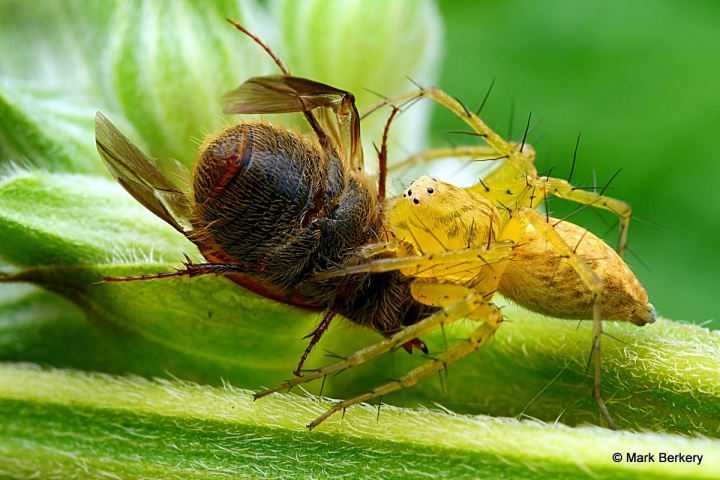
Little Brown Beetle in the deadly embrace of a female Lynx Spider. She went on to have lots of healthy babies.
When I’m in nature (or not) my approach is simple, I let the creature show itself. This means I have to be still, inside and out, or I won’t notice the often tiny movement or flash of colour or contrast that indicates something live and unusual. Stillness of mind comes from an absence of thinking, by attending to the sense or sensation – after the necessary technicalities have been understood and practiced enough. Meditation, on the sensation inside, where else, is a practical preparation for my approach and is either something you are attracted to do or not.
It engenders presence and poise, present for the opportunity and poised for the shot.
Seeing :
The art is to see or visualize a point of view other than the actual, to ‘put yourself in an other’s shoes’, or just put yourself in another position than the one you presently occupy. Apparently this is not a common ability but I think everyone has it to some degree and it can be nurtured when brought to awareness. Being able to see inside what shot you want is half the work, it’s the basis for the shot you get and you always work with what is presented anyway.
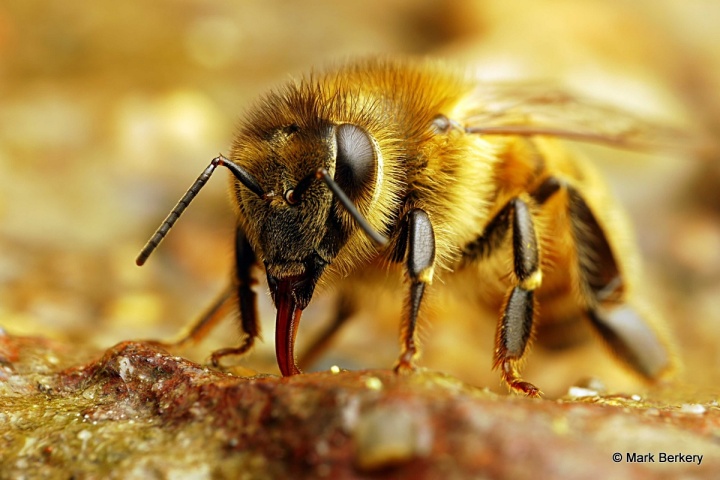
A Honey Bee slakes her thirst at the creeks edge in the height of summer. Water to be taken back to the hive.
This basically means when I see a creature in a position I can get a shot of I look to see if I can get the shot I want, knowing from experience what angle works best with the creature’s particular architecture with consideration for background, contrast, lighting and reflection, the basic composition of the picture. A balance of elements.
Insect architecture is a necessary consideration since the depth of focus is so shallow at high magnification, even with small aperture, that it is necessary to maximize it by placing the plane of focus according to the plane of the creature’s body surface/s – when the illusion of deep focus is desired or necessary. It is a conscious minute action or movement.
The Approach :
First of all you have to find the little fellas. In my experience insects are everywhere but more in some places than others. It’s these ‘some’ places that I seek out since the more insects there are the better my chances of getting a good shot. In these places there are hot spots where for some reason there is a concentration of life forms. And it all changes by the season, some places are good at different times for different creatures.
So what are the basics for burgeoning insect life? Well, it’s the same for them as it is for us, food, water and shelter. The best wild places in my experience are usually, but not always, where the clearing or field meets the bush or forest and where there’s nearby water. And it happens from your feet to the treetops, a vast world of exploration.
Out of a forest or bush and water everything grows, plants and animals of all sorts. Everything eats something, some things eat anything, and eating goes on all the time. When a small creature is eating it is usually too focused to notice a careful and cautious approach.
You can find insects everywhere. In the garden, on the wall, under a log or stone, even in the letterbox – I’ve got a Gecko living in mine – but more often than not it will be on another piece of nature. There is no end to the possibilities of finding insects and often all it takes is to sit down (or stand still) in appropriate places and wait for them to show themselves. And they will appear if you stop, and look to see, not to get.
So, there are insects and other small creatures everywhere and I want to take their picture, how to do it? With respect, is the short answer. Creatures, again, have the same basic survival instincts as us. Though they don’t reason or analyze as we do they are still sensible, because sense doesn’t depend on thinking – what sets us apart. And those senses are of their environment so the less impact you make on it the more likely you are to get close enough for a shot or two.
The fundamental instinct of all living creatures is survival and reproduction, and anything that threatens or appears to threaten that will trigger the fight or flight response – there is also the drop dead response, where at the slightest sense of you an insect will just fall over as if dead. Only some, this is why when shooting stinging or biting creatures I always leave them a clear path to run or fly away. Never trap a biter or stinger unless you are willing to endure the possible consequences.
Insects sense what they do, probably not very different to us even if not exactly the same. Some taste with pads on the feet, others smell with the antennae, feel through air pressure hitting sensitive body structures such as hairs or skin and I don’t know it all – that’s for sure. They can hear, see, smell, taste and feel the vibrations of wind and movement. So it pays not to offend or shock any of their senses.
Does that make sense?
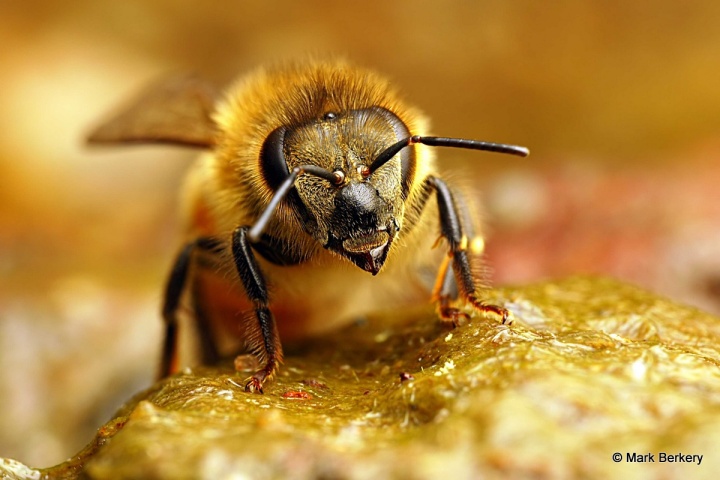
European Honey Bee in momentary pause. Take the shot you can get, you only have a second or two before she moves on.
To get up close with any insect I take one of three approaches. One is to approach it slowly, lowering myself to its level as I get closer to minimise my appearance and not overshadow it, avoiding sudden movement or striking its perch, like a cloud in its sky. Another is to watch and wait until it is focused or occupied with something, move closer and stop if it changes focus, and this way get in for a shot – it usually doesn’t know I am there. Or there is another way regardless of what’s going on around, just approach in short staccato steps leaving enough time between for the object to forget the last movement – they have a short memory, usually. One or other approach will work best with different creatures, depending on their particular sensibilities.
But most of all I don’t get anxious so as to keep the experience a pleasure. It is a kind of hunting, or stalking at least, which essentially is a form of self discipline. Control of mind with regard to being present to notice the slightest sign of ‘prey’, and control of the body to minimise the footprint in the creature’s sensible domain. It also takes considerable discipline to evolve through the learning of what is and is not viable, and its application in the process of capturing the image. Self discipline, is there another kind …
There is no substitute for experience.
Equipment :
Physical size, weight, expense, image noise, processing speed and the size of the frame are the primary differences between what I use and the ‘average’ dSLR. My older camera is the Panasonic FZ50 which is small, light, relatively cheap, a bit noisy – digitally – most of the time and has a small sensor so the frame is small and easily filled. It has other attributes that make it ideal for me, regardless of its obvious (to me) failings. I don’t think it matters what you use as long as it does the job for you, as long as you are comfortable with it. My camera is called a ‘bridge’ to note its similarity with a dSLR and it has the equivalent of a 400mm internally zooming lens on which I mount a variety of achromats of varying dioptre strengths.
I have updated my camera equipment, see below.
I am now also using the Panny G1, with Oly macro lenses and the famous Kiron 105/f2.8 1:1 manual lens, an antique but very good glass, as I want better resolution and IQ – sharpness, clarity, dynamic range etc. Some of these pictures were taken with some variation of them.
With bigger sensors comes the ability to print bigger without the distraction of noise in the image, or the loss of detail from the use of noise reduction software. Plus the articulating LCD’s – my cameras must have – make them indispensable for the angles you can’t get with a viewfinder. Much of the so-called modern, and expensive, dSLR is actually old technology with a digital sensor instead of film. Various camera companies come out with such incremental changes most of the time it is hardly worth the time keeping up with it. I just keep an eye out for an upgrade, or the equivalent, to my FZ50 – I will recognise it when it comes, if it comes.
It came … see below.
An achromat is a two or more element magnifying lens that screws on to the lens just like any filter that comes in varying dioptres or strengths, just like reading glasses. They work best on long focal length lenses since they magnify what is already there and they effectively shorten and fix the working distance – from lens/filter to object – according to dioptre #.
I generally use three achromats. Each is made of quality glass and has a different dioptre strength. One is a +2 dioptre that gives me a working distance of around 18 inches and is good for Butterflies – don’t see many of them – and Dragonflies, so I can get the whole creature in the frame. Another is a +4.5 dioptre with a working distance of around 8 or 9 inches that I rarely use on its own these days and is good for larger insects. The third is a +8 dioptre with a working distance of around 4.5 inches – this is the one I use most on the new setup of G1 and Olympus 60/f2.8 macro.
Very often now, on the old FZ50, I stack the +4.5 on the +8 which gives me a working distance of 2.5 inches. This is considered to be too/very short by some but I find it very comfortable as it gives me more control over the scene and especially the lighting, but it doesn’t work for everything since, obviously, I have to get closer to the creature.
I have a fourth achromat, it’s a +20 dioptre and I only use it where I can take my time and have absolute control, as much as it’s possible anyway, since the DOF is less than wafer thin and so difficult to work with. Each achromat or combination has its time and place, depending on the situation – size of the creature or object, its tolerance or awareness of my presence and the physical limitations of the environment.
Macro magnification is something you get used to working with over time. I graduated through increasing magnifications, each increase giving a corresponding decrease in the depth of focus (DOF) requiring increasing degrees of self control. And like any exercise it gets easier with practise.
The more you practise the easier the muscles involved in maintaining position or balance do the job. Remember, you’re working with very shallow focus that is not easy to place where you want it, it takes time. The same applies to mental control, or focus, it gets easier with practise.
Do you understand all that?
DOF :
Or, how deep is your focus? The very big advantage of small sensors for macro is you get the same image in a smaller frame, relative to the bigger sensors of dSLR’s. Small sensor equals small frame, relative to the object at relative magnification. Though if the M4/3rds makers would produce a decent internally zooming macro lens with good AF I would be happy to use it more – and they have, see below.
What is macro is simple for me. The way it works, as far as I am concerned, is this : Macro magnification is generally regarded as 1 : 1 or 1x, this means 1cm of object width (for instance) takes up 1cm of sensor (or frame) width. So, if your sensor is 7mm wide and the object is 7mm wide the frame is filled with the object. If your sensor is 21mm wide and the object is 7mm wide then the object covers 1/3 the width of the frame. Both are macro, or 1 : 1, or 1X because the object is ‘life’ size on either frame.
There are complicated technical discussions about what is macro and the various characteristics of the genre but it just doesn’t matter to taking pictures in the field – except to the mentally adjusted, anyone who has to know the math. I take pictures without regard to this notion of what is or is not macro or numbers of any kind except shutter speed (SS) and aperture (f#).
It’s the picture that matters, not the numbers.
Lighting : 1st version from 2008.
99% of the time I use flash and again I am a minimalist, I don’t like big and bulky. It gets in the way or just gets complicated. So I use a DIY snoot/tube/cone … On the first picture below you can see the snoot is over to the left. I can rotate or flip that over to the same position on the right, and fix it at any point in between by the use of Velcro strips – not shown.
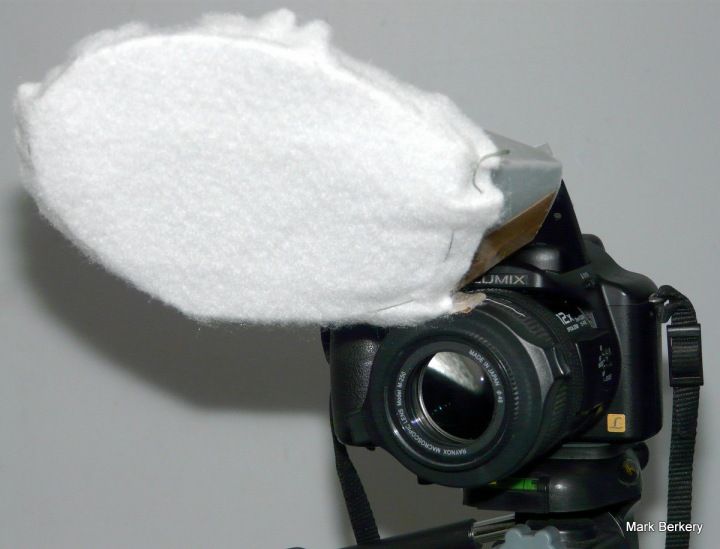
These three pictures are of the original FZ50 setup. See the three below for the latest at – 24/12/15
Ignore the tripod, it is only used to hang things on :
You get the idea …
And this bit of diffusion on the lens helps a lot when WD is very short, everything is variable.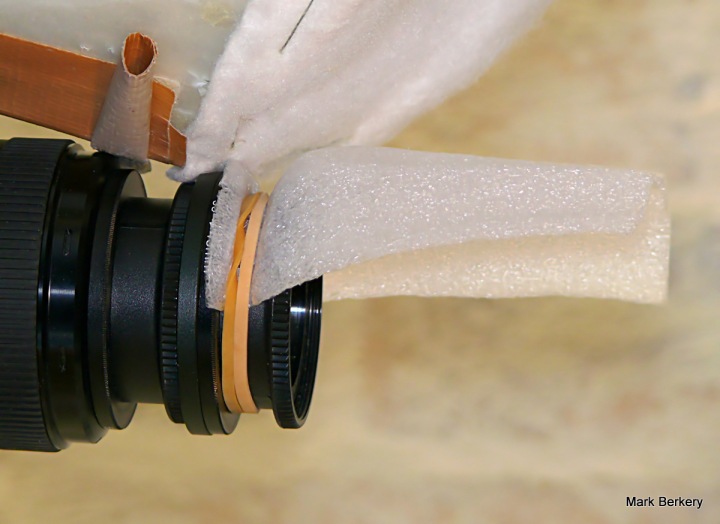
I want to be able to deliver the light to where I want it, at the angle I want it, and diffuse it according to my taste – which changes with experience. Flash mitigates against motion blur at macro magnifications.
*24/12/15 from here –
Then there is the inevitable progression to ‘better’ image quality, requiring a change of equipment from the ten year old FZ50 (+ the G1 + Oly 50/f2 + achromat/s for MF) to a second hand Panasonic G6 body with a Olympus 60/f2.8 macro lens. With a +8 achromat attached this setup does nearly everything the old one did only better, especially the AF (auto focus) and dynamic range.
The principles involved are exactly the same as with the other cameras. The biggest changes, apart from gear, are the weight and more permanent design of the snoot (green plastic cone) and the addition of a smaller focus light – not fixed on yet – to aid in low light or when the back-light forces the camera to darken the subject so it won’t AF. I have used a lighter diffusion material, crimped elasticated cotton stapled to the plastic. The black line you see crossing the green is elasticated nylon to help control the positioning of the diffusing disc of cotton – it can still be flipped left or right to vary direction of light albeit less than before.
The snoot is lined with creased – to aid in breaking up the path of the light – plastic foil and 1/3rd the way down the tube I have added a pad for pre-diffusion. It’s basically a disc of loose weave filler suspended about 1/2 inch from the sides using gaffer tape – so the flash isn’t producing a hot spot in the middle. It’s still a work in progress.
Here’s that little black focus assist lamp clipped on another kind of lamp I have also used for AF assist. The small one fits to the lens and the bigger one to the snoot. The small one gets more use these days. Both can be found online. And that’s about it for the new setup. Most of the pictures on this page now are with this new setup.
*Added 24/12/16 –
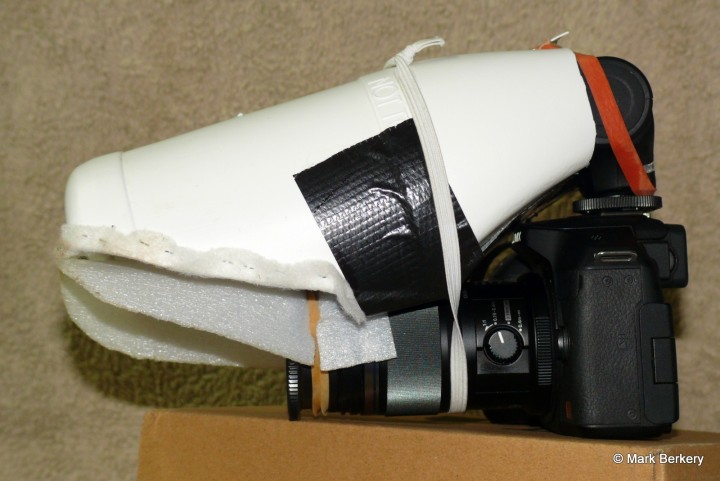
This is basically my setup these days. New 2 AA battery flash, small and light, and minimal light loss from snoot/diffuser so power lasts twice as long as camera battery.
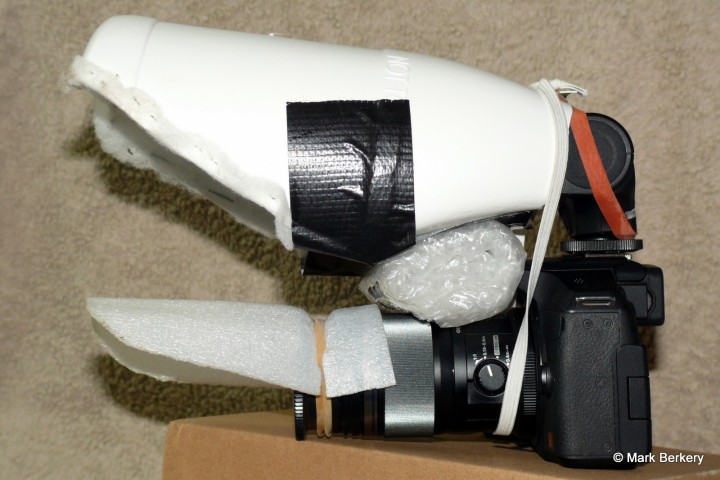
Just to give an idea of how it’s used. Snoot can be elevated if desired, for longer working distance.
Built on the same principles as the others, so nothing new really, just refined.
Now back to the little beauties, to me … some taken with new setup.
Flash :
Effectively I let the flash be my shutter speed by keeping it to the minimum pulse duration required for adequate exposure, by minimising light spillage through snooting and getting the diffusion as close as possible to object, can be as fast as 1/20,000 second – and eliminating or minimizing ambient light via aperture or shutter speed – which is one reason I get sharp pictures. Slower SS can be used to allow ambient light if the situation allows and the shot calls for it and fill flash still has motion stopping effect.
Shadowing from directed light gives depth and interest to an image, though there is less of that with the new setup.
Stability :
For composed and sharp pictures at macro magnifications with DOF often less than 1mm deep, stabilisation is a must. I don’t use a tripod or monopod since all my subjects are alive and usually on the move or about to be. They don’t wait for ‘pods to be set up. Usually there is a very short window when the shot can be had and it helps to have some quick method of very mobile stabilisation, especially if I can’t hold the objects perch. My primary solution is a stick.
A smooth polished wooden stick about five foot long and no thicker than my thumb. I use it gripped between left fingers and cam (or somehow or other) so if I release the pressure it slides easily up or down at will for vertical stability at any practical height. It can also be planted in the ground at different angles to maximise horizontal stability at any height. In fact, between my knee on the ground and my other foot planted away for stability, the stick acts as the third leg of a very articulate tripod – me.
Don’t think about how you can make a stick work for you, try it out and its working for you will unfold as the necessary mechanics to maximise stability. Just feel free to use it any way that works for you, for stability. Your keeper rate will probably double soon after.
The stick is the third leg of the tripod, you are the other two, or three or however many points you use to brace for a steady shot. It also doubles for walking, snipping spider webs cast across the track, a warning to snakes in the long grass – whatever it is to you.
You don’t need a picture of a stick, do you?
Another way to stabilise with very short working distance is to hold the leaf (or whatever) the creature is on in left hand and rest the lens on the same hand. Both on the same platform means if one moves so does the other = stability, relatively speaking. It’s all relative, isn’t it.
Working distance is relative to magnification and the actual size of the object you want to capture an image of. The bigger the object, the lower the magnification required, the longer the working distance.
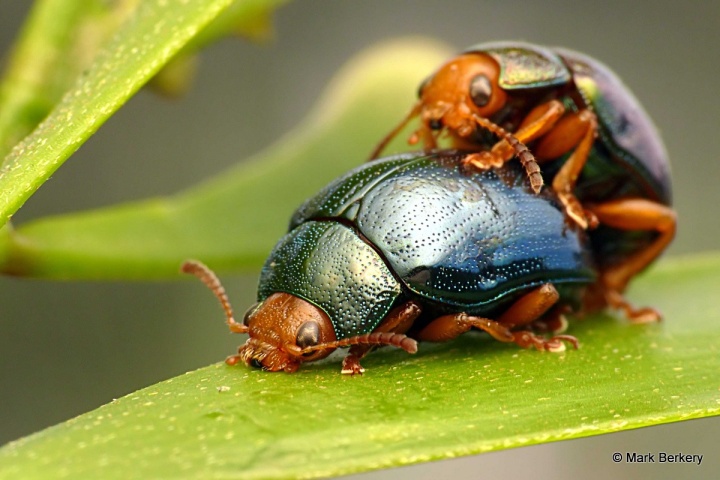
Mating Beetles, very sensitive creatures, will fall to the ground in response to a perceived threat.
You have to get creative, which is where relaxation and meditation helps greatly, in my experience. Allowing you to see without the limitation of thinking.
Settings :
As already indicated, I use flash and largely exclude ambient light for sharpness. I use manual mode and my shutter speed is kept at dSLR specs (for when I use the m4/3 – so I am used to the slower SS) and my aperture is usually as small as I can have it within diffraction limits – don’t ask. In all but the strongest sun this is enough to eliminate ambient light so the flash is the effective shutter speed – very fast = sharp. The maximum synch flash speed on most DSLR’s is around 1/250 which is enough most of the time, it’s also a serious limitation when you need faster and don’t want the multi exp of high speed synch – old tech.
If I want ambient light in the scene, for effect, or because the creature is dark and there is no immediate background to bounce light off I will just lower the shutter speed. On my camera I never leave base ISO for anything, another restriction of small sensors – presently. Variation in ISO is really only necessary for natural light shots, since flash effectively controls exposure.
I usually set the camera to underexpose using flash compensation through ETTL, to keep the highlights from blowing – being able to vary the angle of the light helps too – with reflection. You don’t want light bouncing directly back into the lens. This underexposure also has the effect of saturating the colours.
I’ll say it again, there is no substitute for actual experience. Any guide or book should only be to help define that.
Focus :
The first focus you need is inner, focus of your attention. If you don’t have that you won’t get it in a lens, not enough anyway. And the kind of focus you need to actualize your potential can be developed.
Probably the single most important aspect of any picture, focus, for without focus where you want it you don’t have a picture worth looking at. It’s normal to focus manually in macro but I believe that is only because the equipment most people use doesn’t auto-focus very well, and/or they don’t know how to use AF for macro.
I use AF with the (1.5 inch) LCD on 2005 technology – it’s now end of 2010 (March 2013 – Jan 2015 – Jan 2016 and new setup) – known for its poor low light performance so it can’t be bad, can it? I do it this way basically because I find it easier than using the viewfinder.
The new setup, G6 and Oly 60/f2.8 with +8 achromat has very fast and accurate AF, within the limited distances it will focus.
I’ll tell you how I do it. First I have a look over the top of the camera to see which part of the creature I want in focus first, and then I aim at that point through the LCD, having single centre point focus set on the camera. As soon as focus is locked I press the button the rest of the way – without delay – and voila, I have the shot – usually.
Any delay at all and the creature has probably moved through the field of focus and you won’t get what you aimed at, or you have moved and the result is the same.
Of course there are misses, as with any technique. And there is back and forward focusing issues with some lenses but not mine, up to 2 : 1 magnification. Everything can be compensated for, gotten used to.
Another consideration that has to be made when using AF for macro is the fact the focus point has before it an area of acceptable focus that can be better placed more on the object. This requires the smallest of movement towards the object to achieve it, resulting in the optimum use of the field of acceptable focus, with a bit of luck – because I can’t actually see it. It’s what makes the difference between something that’s just in focus and something that looks like a focus stack or deep focus.
Or, taking the objects architecture into account, I aim for a point just behind where I want focus to ‘begin’, is another way of doing it. And different methods work best at different times with different shapes and structures. With this way I need to be able to judge minute distances, a kind of intuition that requires refined muscle control – since it only comes with experience and understanding.
Either way, at times it’s not unlike shooting an arrow from horseback at a moving target, it’s an art. I find if I have inner focus the outer happens more easily.
Auto focus works, as you can see from my pictures, so don’t knock it.
Manual Focus : Or MF, is necessary on most macro lenses attached to a DSLR, as with my Oly 50/f2 macro lens attached to my Panny G1. I still use the articulating LCD and the way I do it is the same as for an optical viewfinder except the view is not so resolved. So it is a matter of judgement, because I don’t actually see what’s in focus.
The action is, with lens in MF and at the appropriate WD (working distance), move in to the object to be imaged until the area you want in focus first loses focus – it becomes blurred. Then move out from the object until that same area comes back into focus and shoot – press the shutter button. Timing is critical, you get used to it.
Processing or PP :
I aim to get the picture as near as I want it from the camera so when it comes to processing I am minimalist again. I always shoot in JPG with camera on minimum picture settings, contrast, saturation, etc. So I have more control over the picture. I have seen some mastery of the processing of some RAW files but not enough to tempt me, yet.
And you know what happens when life contradicts.
With macro, unless the object is absolutely still and not likely to move, and the camera is well braced, I frame with the option to crop for composition. Many of the shots I take are of moving targets so this a necessary compromise. It’s a compromise because I don’t like losing the pixels or resolution.
Then I’ll saturate with an eye on the reds or yellows in particular since they seem to blow first and I lose detail. I usually underexpose a tad so I will then bring up the brightness with an eye on the histogram to keep the highs from blowing. And may darken shadow for contrast.
I also de-noise and sharpen in a dedicated program. And that’s usually it. Maybe a little cloning now and again.
The Shot :
Getting it … Here, after all else is taken into consideration, it’s a case of the more you shoot the more keepers you will have. Don’t mind the people who say if you don’t get the shot in a few frames you’re no good, they haven’t tried macro of living creatures in their own habitat. Macro may be the most physically demanding photo discipline so practise is imperative for the often minute control necessary at high magnification – shallow DOF.
My keeper rate varies from 90% in situations where nothing moves and the positions are comfortable, that’s about 10% of the time, to 5% or so where the light, physical position or whatever are just not conducive. The more usual keeper rate is between 30% to 50% since I just love capturing the small creatures in pose or action, or both. So I bin a lot. (It is now – 2016 – years since I first wrote this and the keeper rate is much higher than previously stated.)
And they are never better than from the wild where you never really know what you’ve got ‘til you get home.
It’s a Setup :
My primary consideration when moving a creature, that is easy to move, is to not harm or kill it, then to shoot it no more than necessary – I wonder about the effect of a lot of flash, and usually give it some water/honey before letting it go where I found it – or similar location. Often I find a couple of hitchers when I get home from the local rainforest remnant. Today it’s a Louse fly, a spider and a small bug. The spider is too small, the bug flew away but the Louse fly is like a yoyo – always returns when I blow or throw it away, when I can find it – so it’s an opportunity and might be good for a few shots later when it cools down.
During the now passing winter here often the only creatures I saw were the ones that showed up at the light at night where I kept flowers and leaves for platforms and backgrounds, and late at night the relative cold kept them still for easy manipulation – coaxing onto a leaf or such. But setups don’t demand full engagement of my attention beyond a few minutes and are largely without the essential element of the creative unknown – essential to me.
That’s what I love about shooting bugs in the wild nature, you never know what you’re going to get and something always shows up – here anyway – even if it’s just a magnificent fly. Some of it couldn’t be devised in the lab, the angles, backgrounds, comps, colours and light. I prefer to let nature set it up and be ready to shoot when it presents.
Ethics? Truth is what you live, or can live with, and if you set shots up why not? And why not tell what you do, if you are asked straight. But then there is the matter of how you go about it. Some don’t see any harm or wrong in immobilizing creatures, by various means, for a shot or stack but the fact is I don’t need such a shot so bad, and I don’t stack – can’t see the point. That’s my position, for now. I always have to qualify my position so because you never know what you might have to do next. But respect for the small things is important to me.
I find it’s best not to think about the ones that get away or I can’t have, except for how I might be ready for it next time or manage a way, if there is one.
A few more words :
There is no quick route to expertise in macro, it takes practise which takes time. Not least because of the absolute need for stabilisation, the quirks of macro lighting and the limitation of DOF. And of course the physical demand of posture takes time to develop the necessary control of the muscles involved. But it’s not too difficult.
And don’t forget patience, or the absence of impatience more like, which can be helped with a simple and practical meditation. You’ve just got to slow the mind down by focusing on sense, inside and out, to enter the wonderful and often beautiful world of bugs at our feet, to see what’s going on and capture an image of it.
As you can see, a lot of how I do it is contrary to the accepted wisdom – which I suspect will change. But, whatever works for you. And last, as it was first, be easy and enjoy the action and the pure and peaceful sense that nature is. By putting it first in your practise and giving up any anxiety about getting the shot.
Relax! It’s enlightening – of the weight of mind.
Insects, our neighbours as ourselves :
This wouldn’t be complete without a word about the attitude of society towards nature in general and insects in particular. We really think it’s ok to exploit nature for short term personal and financial gain, and we are reaping the consequences – though we aren’t really feeling it yet in Australia (Jan 2015 and there is more talk of climate change, temps are rising and weather conditions are reportedly more extreme than previously observed). I understand the disappearance of the usual native, and introduced, pollinators is alarming many in some circles. What to do?
I still run across people who think insects are pests, ugly or dangerous. Something to be destroyed, judged and feared – when all they need is respect. This is not a sane attitude on a planet where those same insects – and others – are intrinsic to our survival. And, in truth, are born of the same mystery and the same earth.
The fact is we can’t do without insects. If they were to die out the soil would become infertile, rotting matter would cover the earth and we would starve, if we lived long enough to. The earth’s ecology would break down, it would cease to be a functioning organism. Earth, as we know it, would die as far as we humans are concerned – long enough for the problem to rectify itself in our absence.
Look at it as if you are the earth and your digestive and immune systems stopped working, how long do you think you’d last? If we are not to ruin the Earth it is imperative we stop killing what doesn’t need killing. Another way of seeing it is all is well, or all will work out. No need for anxiety, but every need for any action you might perceive necessary.
If we die out we won’t be missed by any other creature on earth, except those closest to us, the dogs and cats. They don’t need us, for anything. Except perhaps, being the highest expression of life or intelligence on earth, that we become more intelligent and start to see the beauty and wonder of the whole creation, including the insects.
Do you think it can happen?
Hmmmm!
Ownership :
The ideas here are not claimed by me to be original. Some were born or realised of necessity and experience of getting it wrong, rightly said to be the mother of invention. Enough right practise leads to intuition. And others were necessarily harvested. Ideas are universal, they don’t belong to anyone but who realises, develops and uses them.
If I bring anything unique to the field of endeavour and exploration that macro is, it is the idea that nature is its own value and has its place first in the order of things. Before the ‘photographer’, the gear, the techniques and settings, or anything else that is a part of the process.
Nature comes first because without it the rest is for nothing. Nature as the sense of things, in the actuality, and in that inner sense of quietude that comes from not thinking so much.
And it is putting the sense before the intellectual where the real art lies. The art of being what you are doing without the distractions of personal thoughtful or emotional considerations, being in the senses. And then the art of being before the sense. Requires some negation of the personal, the opposite to what is generally practised.
Some might call this zen – no mind, but I call it being practical because it is something that can be done to one degree or another by anyone so moved and aids peace of mind in any situation. No need to make it special and put it out of reach.
And there’s nothing new about this idea, it’s as old as nature itself.

Beetle meets Ant. They had a conversation and the ant relented, allowing for another at the honey drop.
© Mark Berkery ……. Click any picture and click again to enlarge
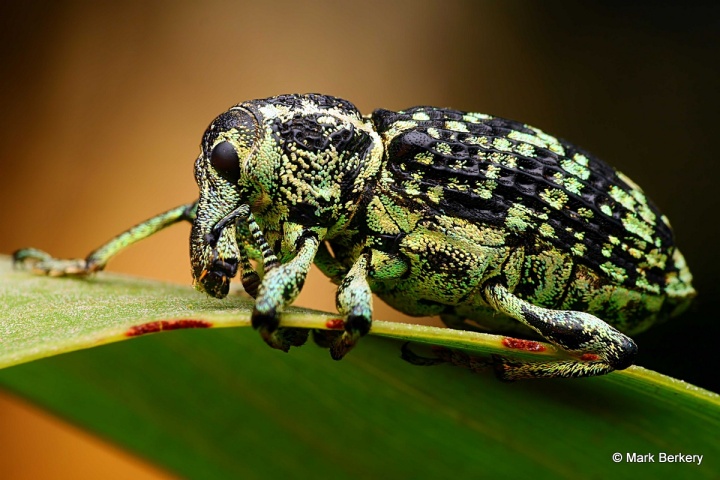

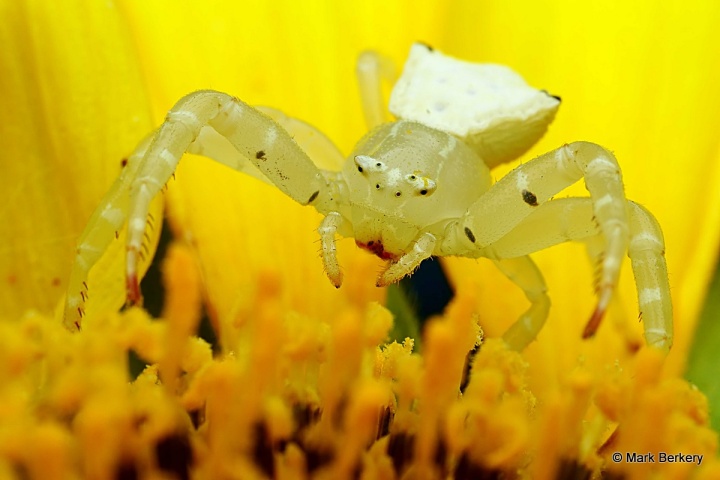
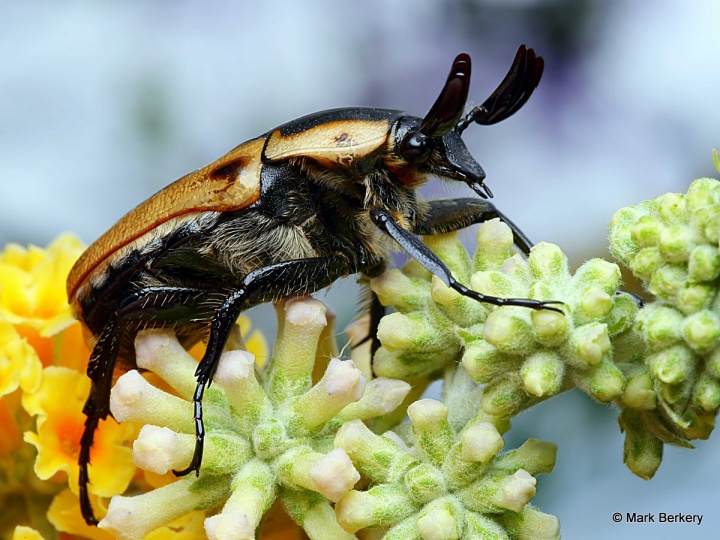
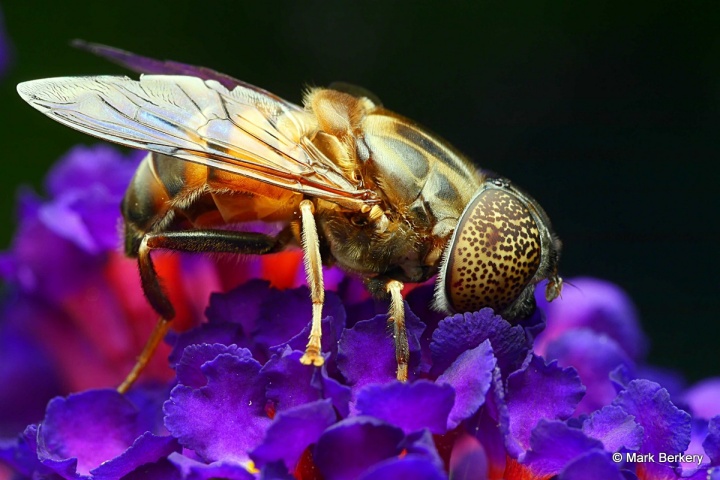



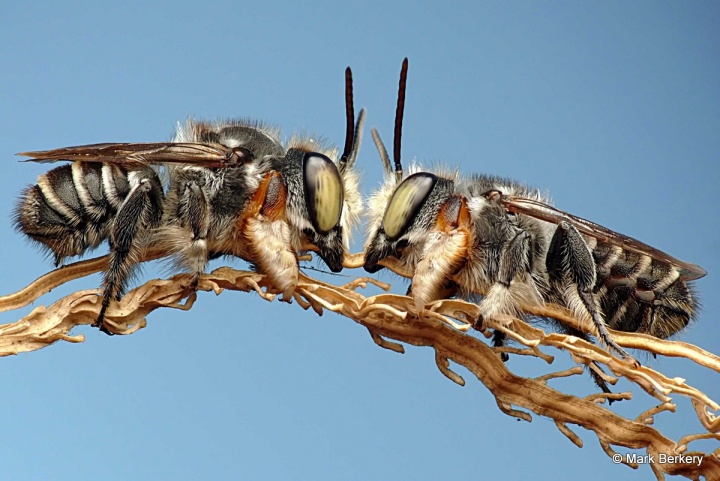

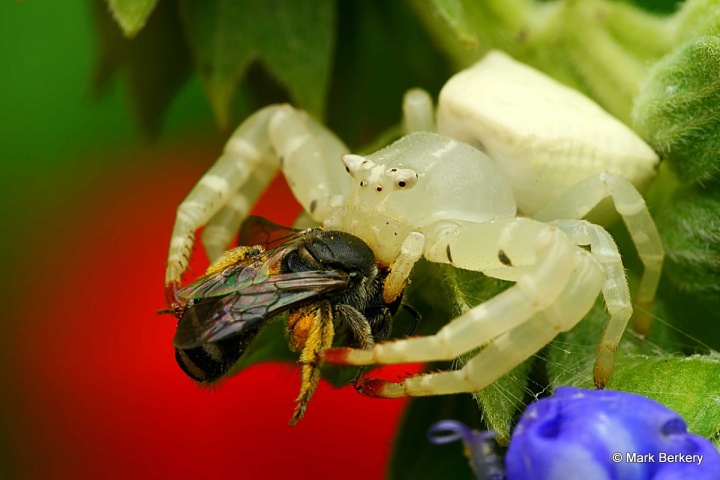
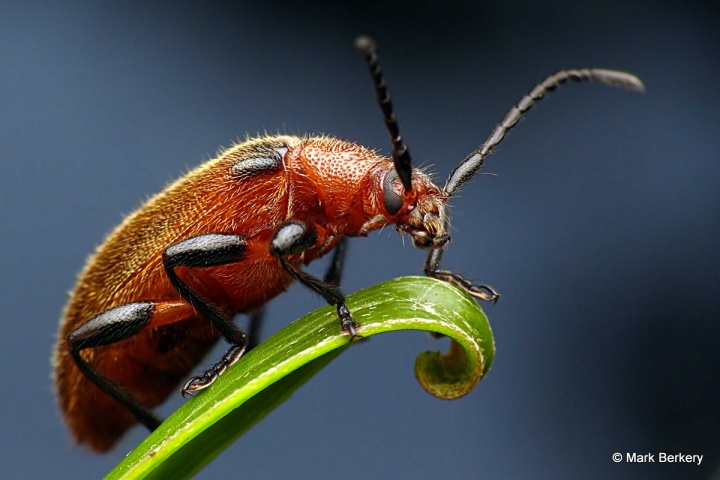
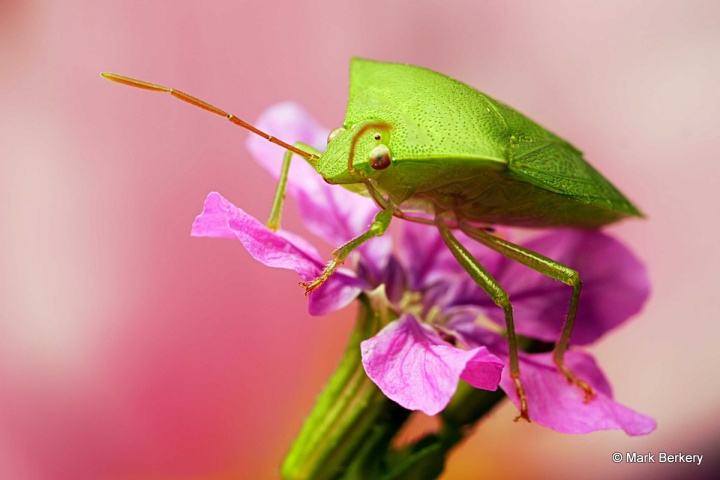
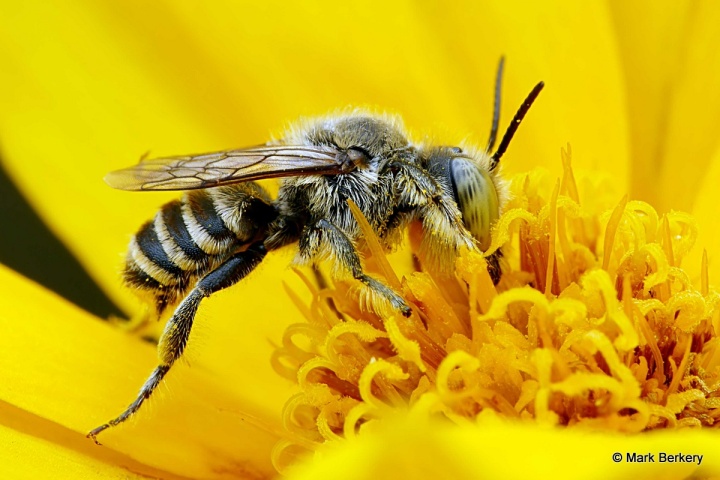
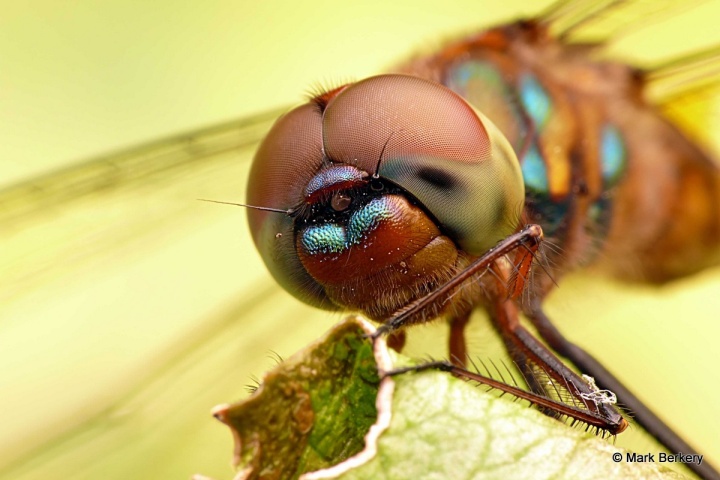

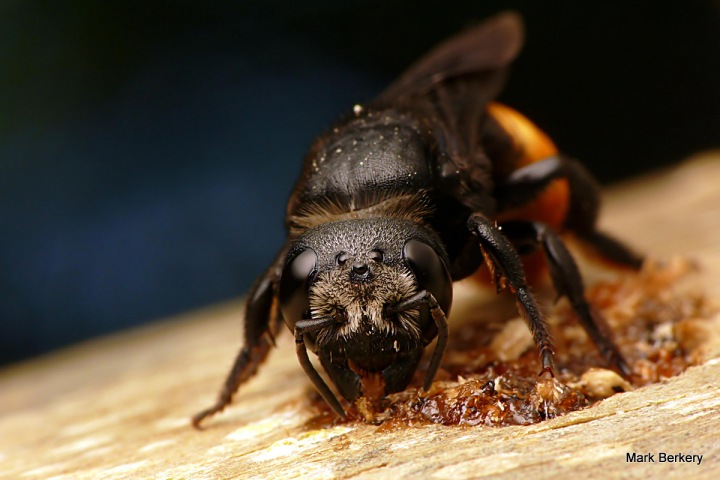



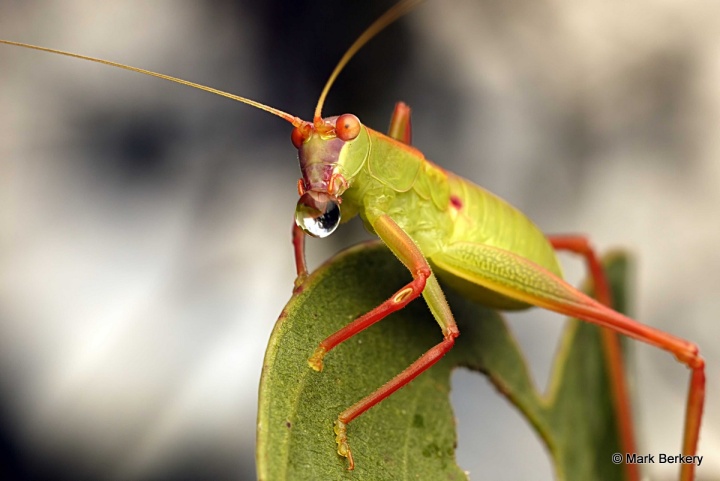
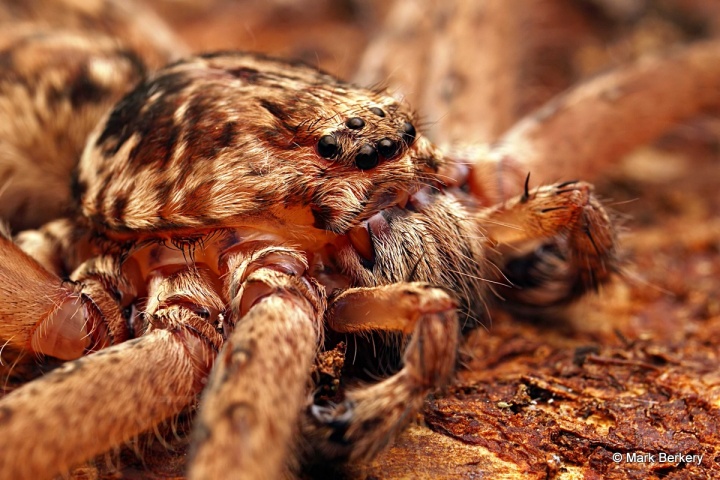
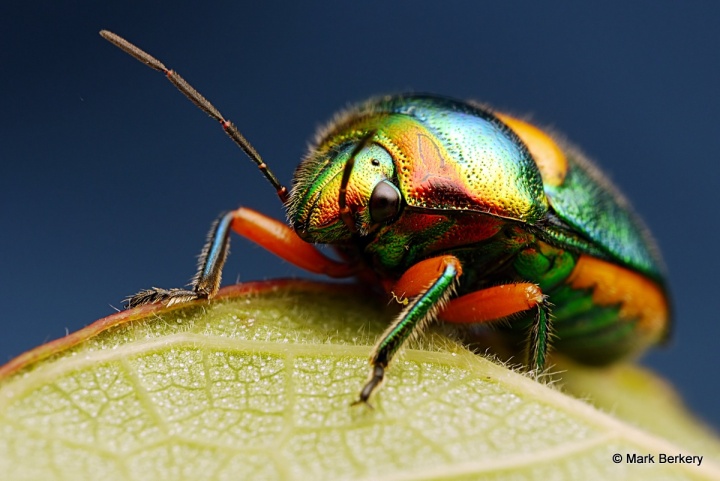
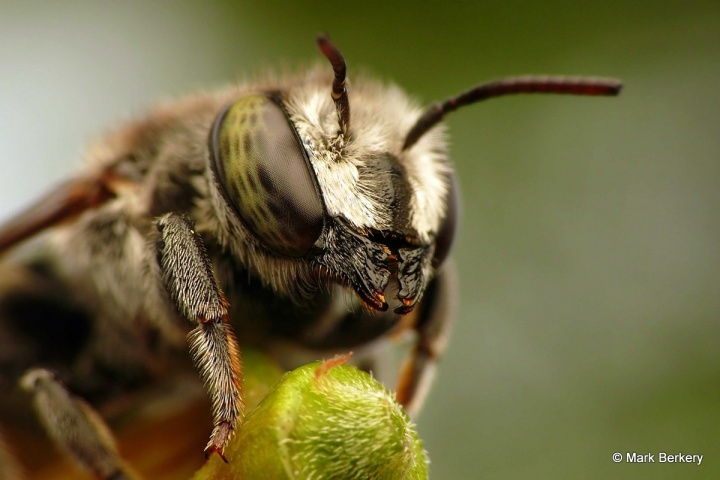
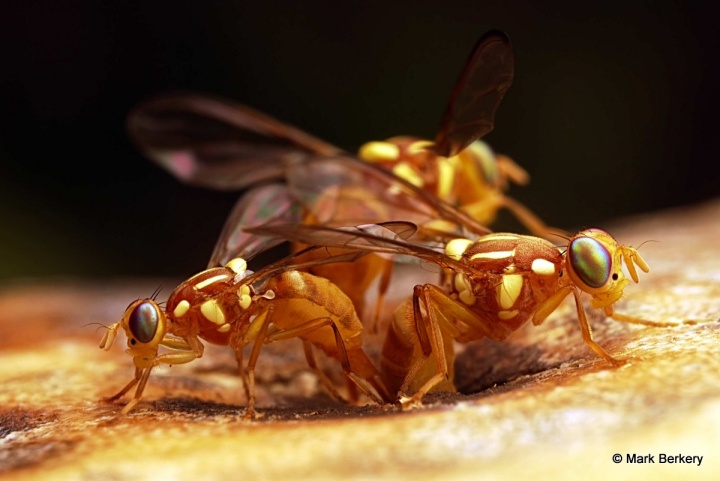
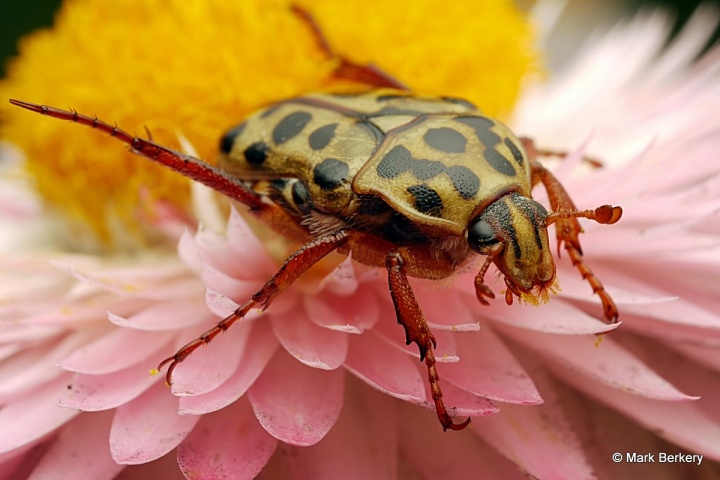

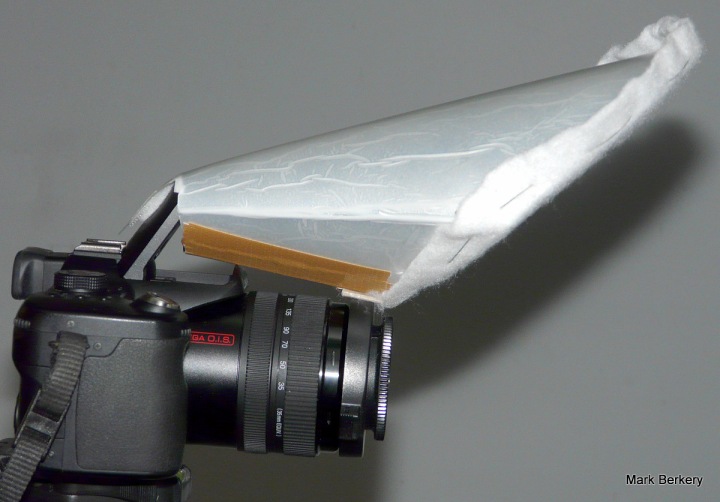
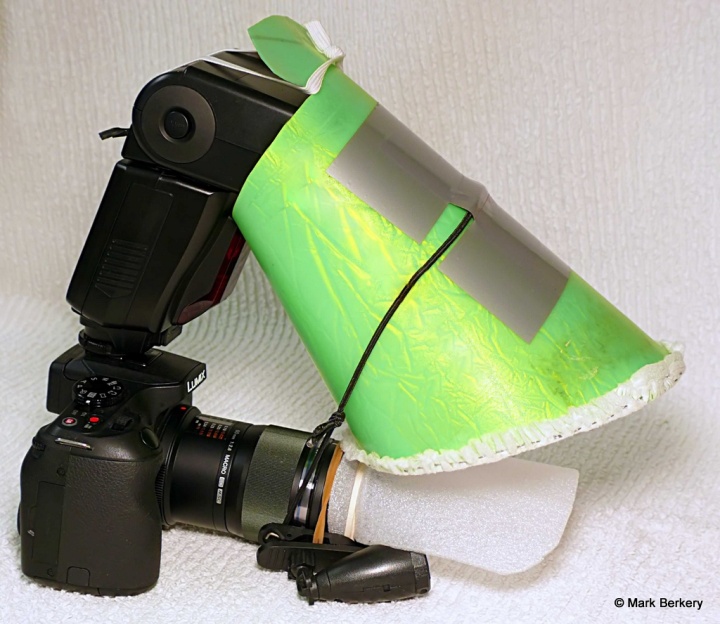
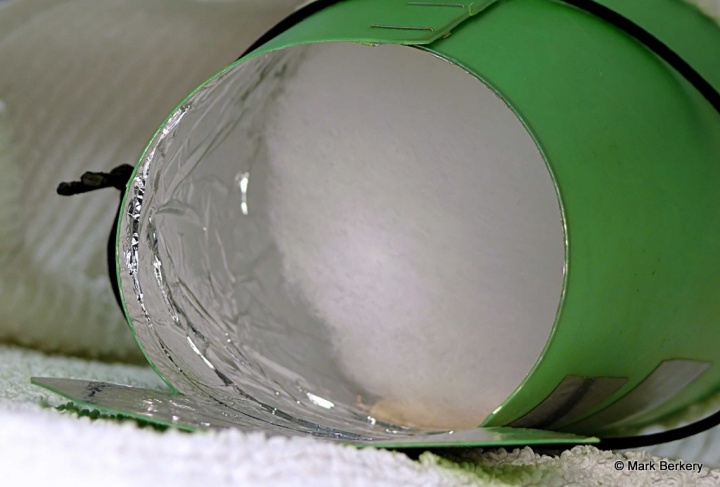
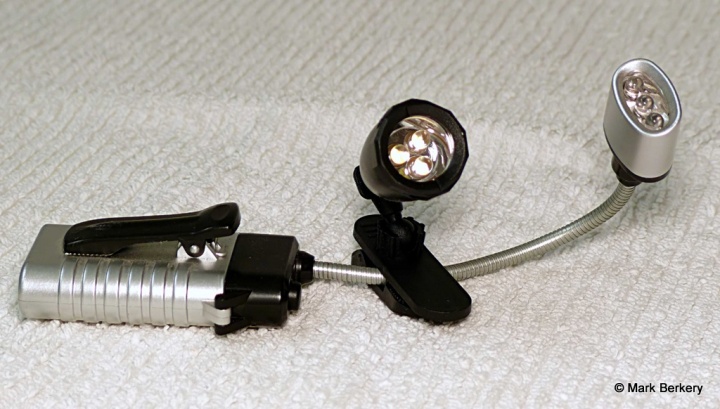
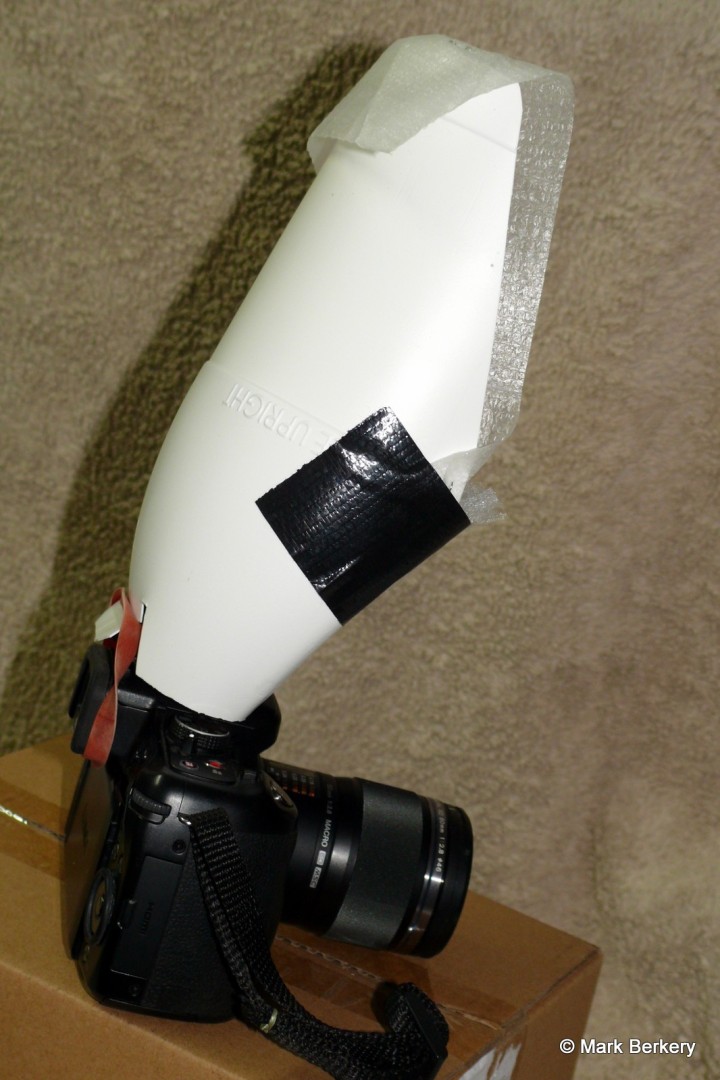
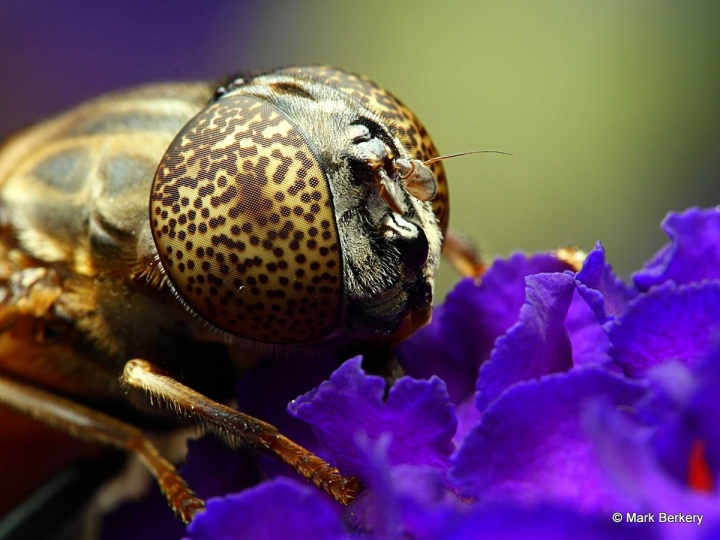
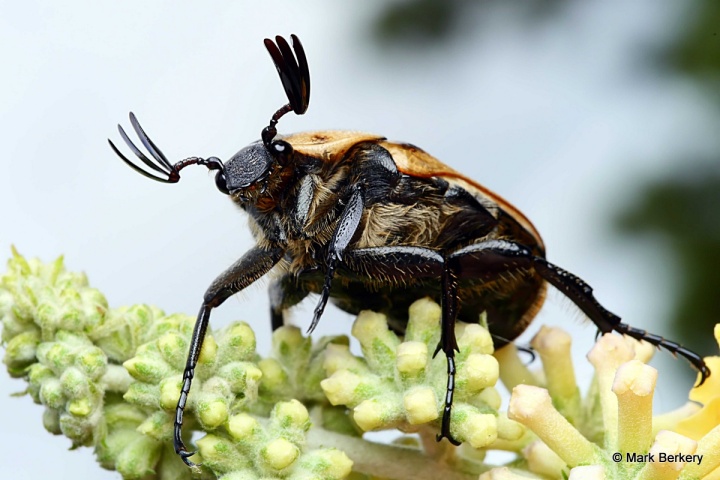



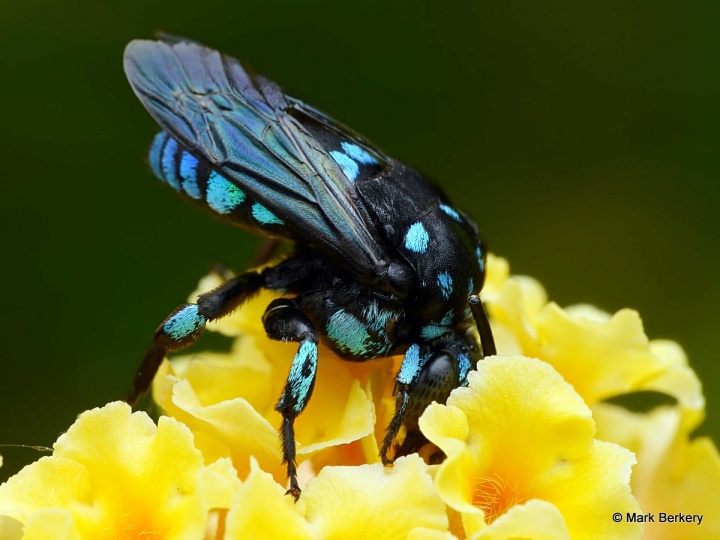


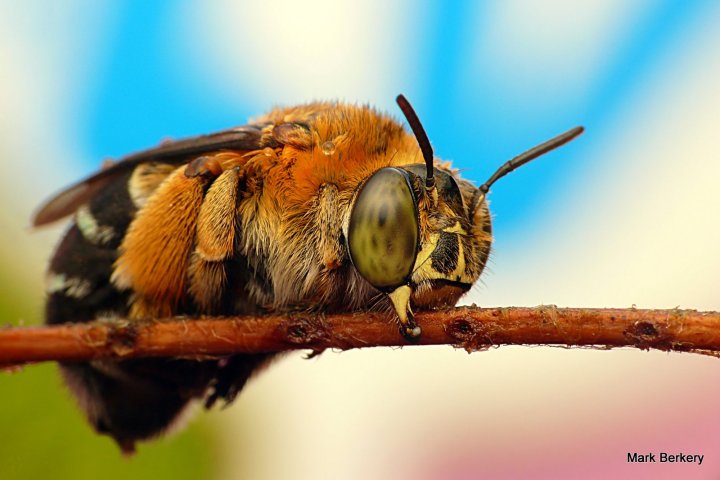





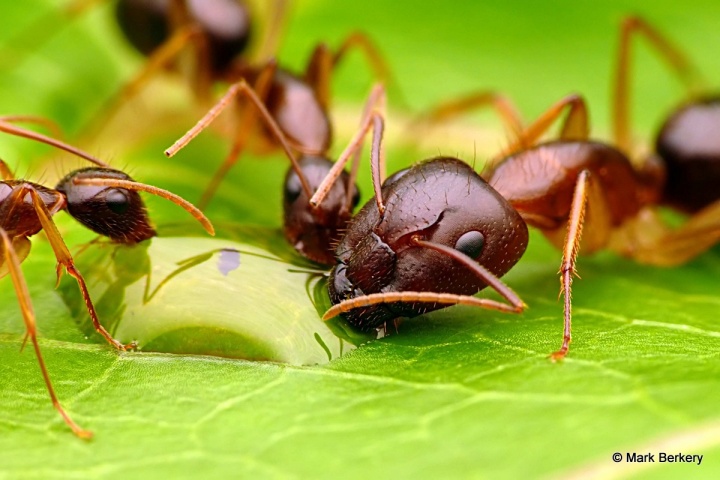
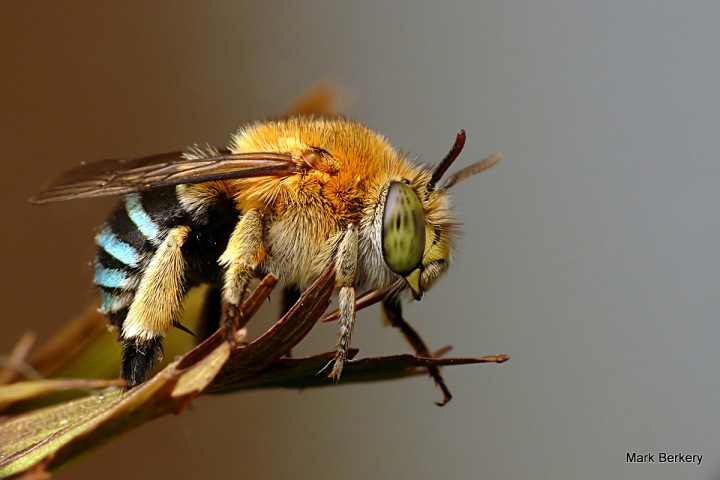
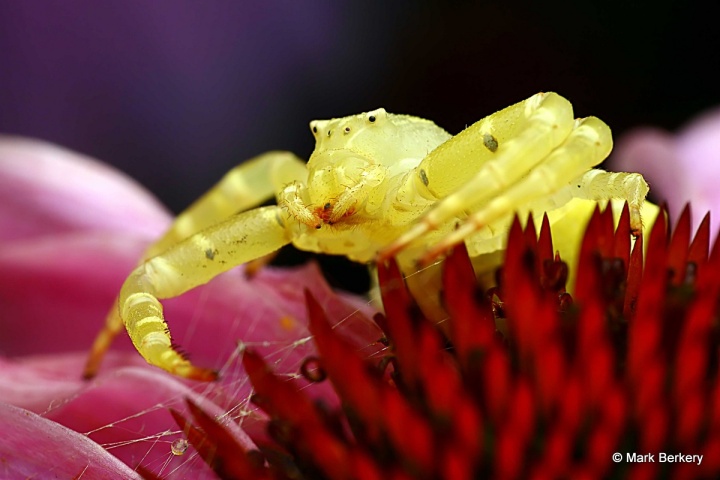
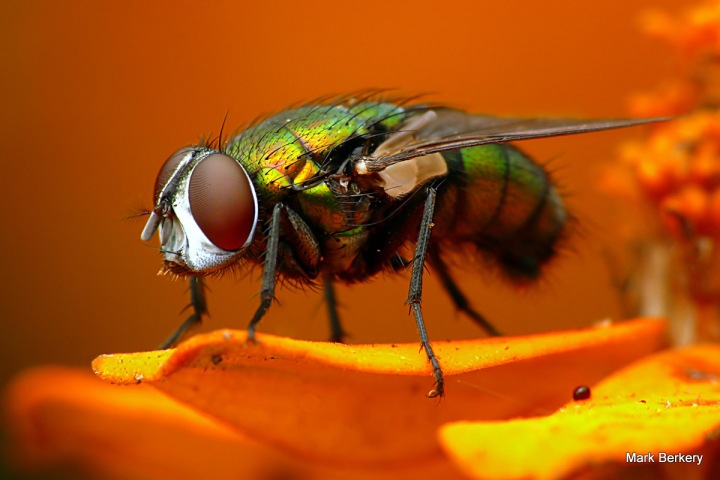
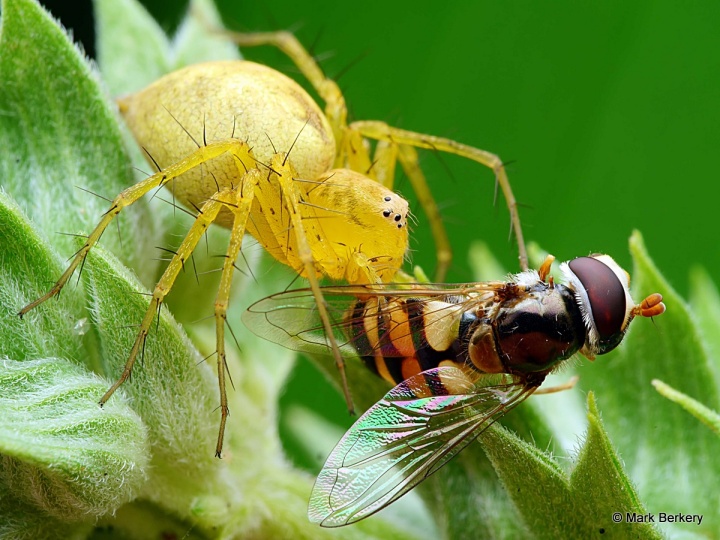
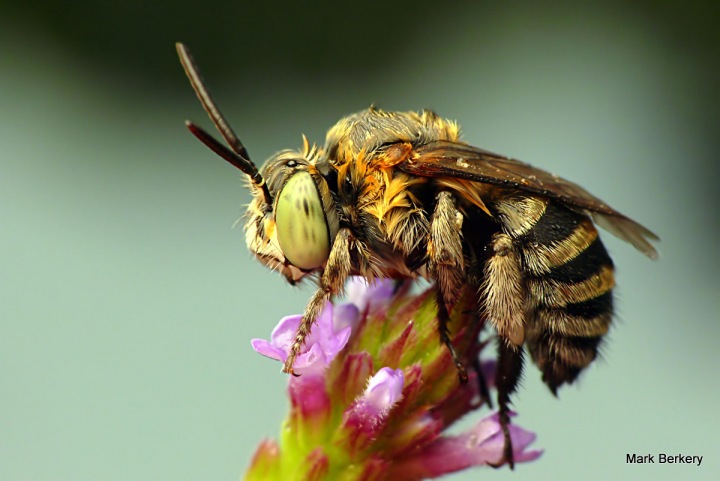
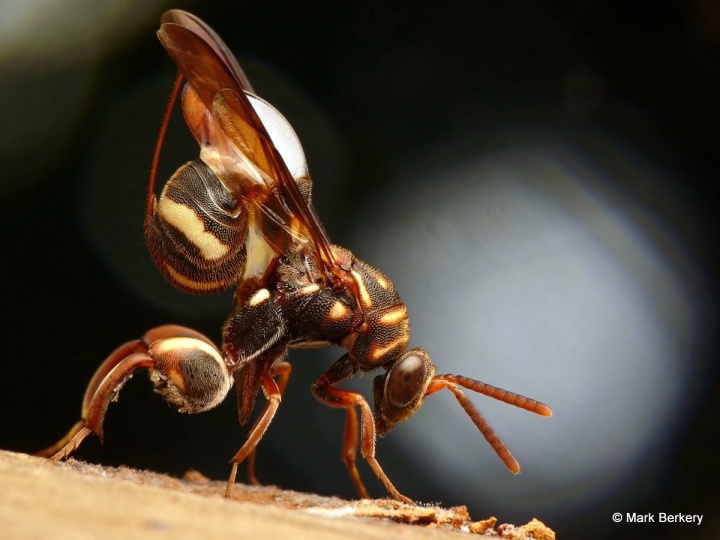
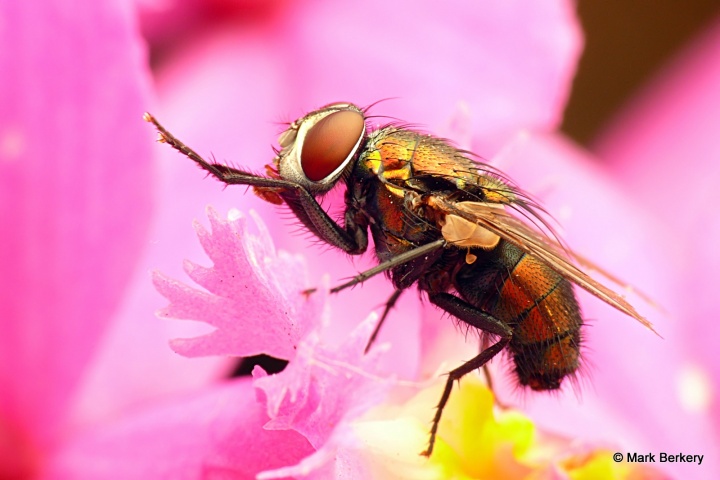


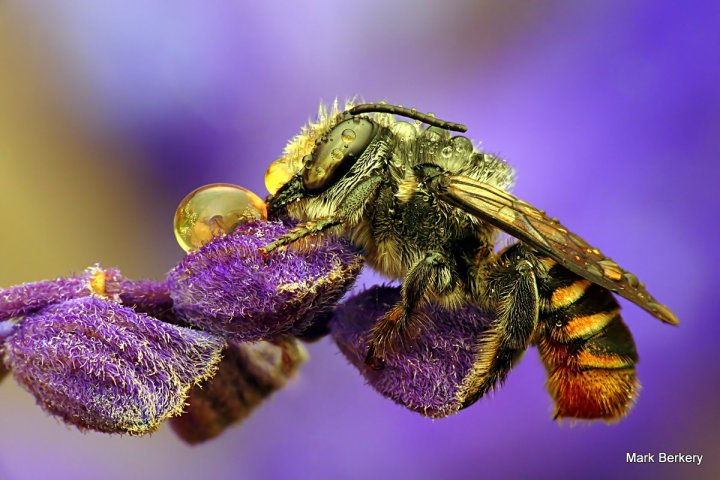
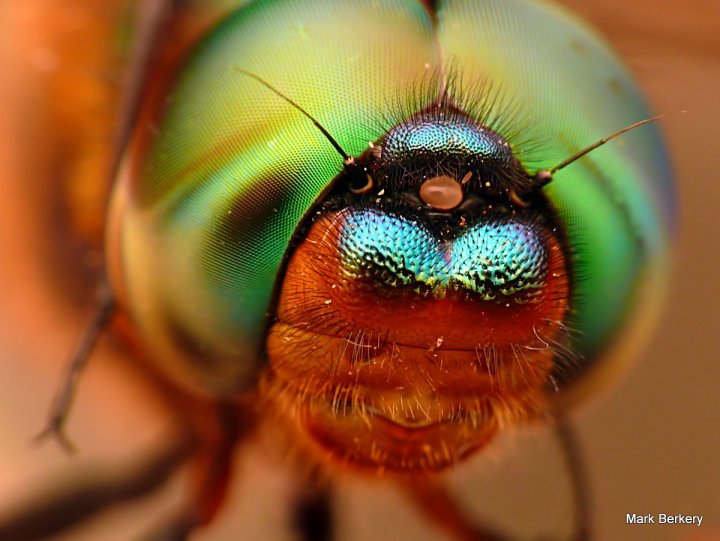





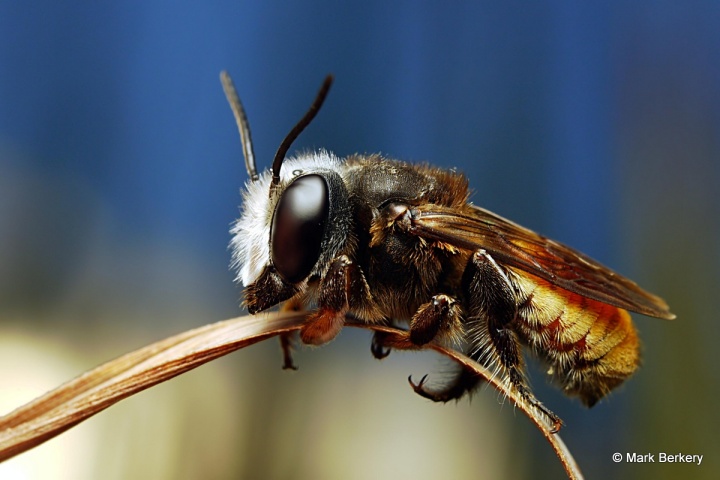



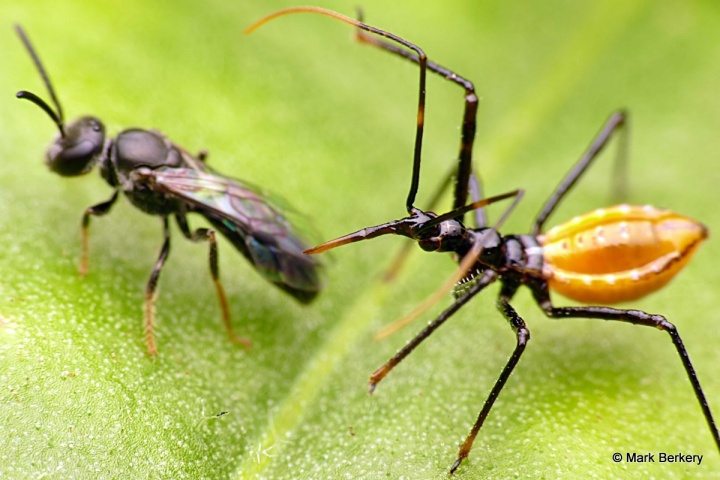
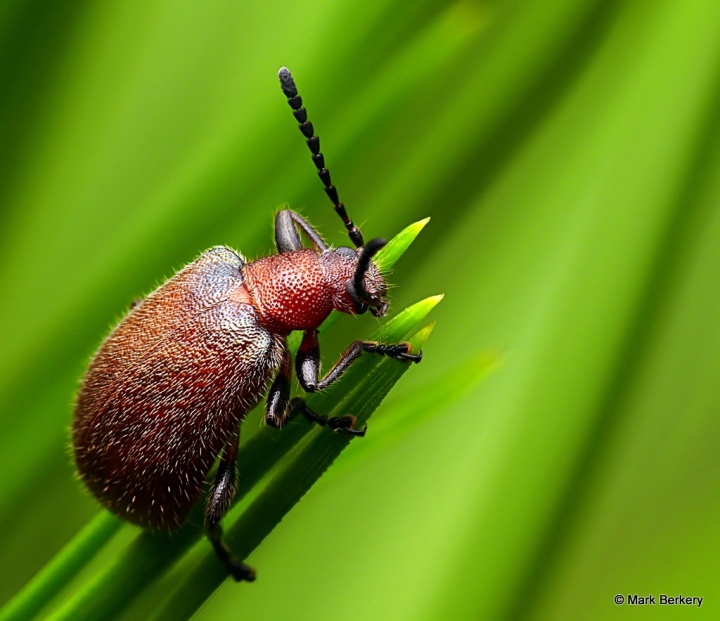


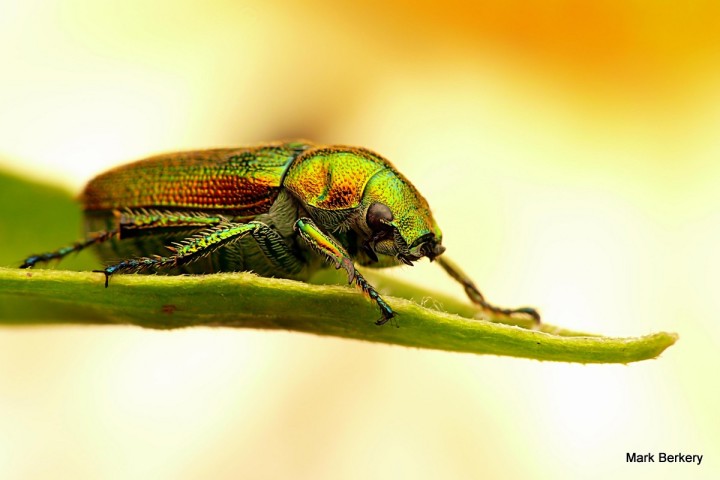


The best explanation of macro theory and practice i have read excellent 👍
Brilliant photos, have you ever used ring flash ?
Thanks. Never, just don’t like the circular catchlight in reflective eyes.
Fabulous. Thank you Mark.
Thanks Adrian.
I cannot understand the Mania for photo stacking these days, you seem to manage perfectly well without it Mark, perhaps it is that magic stick of yours? Beautifull images as usual.
Different strokes for different folks. I don’t enjoy the post processing so I arrange things to minimise it. The stick helps with stability in awkward situations.
Thanks Adrian.
Thanks for these wonderful captures but also for what you showed us about your self made softener for the flashlight.
No problem … And no doubt it can be improved, but it’s good enough for now.
Great article and stunning photos !
Another proof that you don’t need the most expensive equipment to take great macro shots. If you love what you’re doing, you can manage to get excellent results whatever the tech.
Thanks Sammy. A level of tech is required but once that’s in place it’s all about the light. And a few other things.
Great macro photography Mark and thanks for the information you provided. I’m sure lots of us will learn form it. Kind regards, Rudi
Thanks Rudi. :-)
You said it so well, congratulations.the photos are also great . greetings
Thanks …
Wow! iam completely amazed by your photos. I have always been a great admirer of little creatures and have been passing the love for bugs to my boys too. They are just stunning! Especially when seen so close up. Congratulations on your work and efford to capture all the tiny beautiful details of these wonderful creatures.
Thanks Lilian. Just replied to your email, in case it goes to spam folder.
Like your photography & the dedication that goes into taking these extraordinary photos. thankyou for bringing the beauty of all the little critters to us uninitiated. Shared your link on fb. Hope all is well in your world.
Thanks 4 …
Gear … A few people already this year have asked me for advise on what camera (etc) to get and I don’t really have an answer, apart from what I already use. I don’t keep up with what is available and their costs.
Then my attention was drawn to a post on dpr – https://www.dpreview.com/forums/thread/4457129 – by an accomplished macro shooter, worth checking out if you want advise on what to use in 2020.
Some great information and pictures here. I seen some of your macro shots taken with the FZ50 on DPReview. Fantastic results. I own a FZ50 and might get a Raynox 250 going on what I’ve seen you achieve. Doubt I’ll get the results you can get, but anywhere near would be great.
If you haven’t used achromats it might be easier to start with the 150 to get used to the shallow dof. Lighting is the key though, get it right and no reason you can’t get good images. Of course there’s more to it … but if you start at the right place it will lead you on.
Hi Mark,
I read through some of your remarks.
You wrote:
I generally use three achromats.
I posess also three acromats and used them as a whole. That doesn’t make sense, right?!
I should probably use only one each time and figure out which one to use in which situation.
Gerhard
Hi Gerhard.
Achromats add magnification (depending on dioptre strength) and fix (more or less) the working distance, the higher the +# dioptre the higher the magnification the shorter the working distance. Depth of field (of focus), critical in macro, gets shallower too.
Whether to stack them one on the other depends on what you are comfortable with, and what the situation allows, what you are photographing. But a general rule is the glass must be good quality or it will adversely impact the image quality the more of them you stack.
A pin head will require and allow the highest mags as it is small and doesn’t move, whereas a butterfly will require less mags to allow greater distance and field of view so you have some leeway in your approach to a living/moving subject. It’s all relative, one thing is traded off another.
The advantage of flash is the light is controllable at all/most times, plus it helps stop the motion at high mags and so sharpens the image. Check links below in recent comments for some useful stuff on lighting/setups and achromats. If you go to the setups page there are many excellent macro shooters with their own websites you might learn from too.
Thank you very much, Mark!
So far, I have had a very simple method, namely photographing mainly with 1/1000 sec. That worked quite well most of the time,
I did not know about using flash.
I will look at the setups for ligthing.
You are welcome Gerhard.
You might also try different angles for a more intimate presentation, from the side and below (shots from above are the predators view), with the aim of getting the eye/s in focus. The eye is the centre of focus in any creature with them, it’s where the individuals intelligence is gathered and character most expressive – visibly and invisibly.
Here’s one thread for setups from a famous macro forum – https://www.fredmiranda.com/forum/topic/780820
Yes, I always try to catch the eyes of insects.
Tansy shrubs are very low, but I can also shoot from below with ivy. It is also of interest to see the bottom of the animals.
Thanks for the link!
An articulating LCD is helpful for shooting from angles/positions you can’t actually get into.
A suitable diameter and length stick is a versatile support/pod to help stabilize the shot.
Thank you.
I must confess: I never used my LCD for shooting insects :-)
Hi Mark, this blog post is so inspiring and i’ve come back to it several times for help. Everytime i read through it i discover new things to try. The only thing that i can’t seem to solve is to get a good background in my photos. Mine always tend to be black. Do you have any advice on how to better the background?
Last question, what role do the led lights play in lighting your subject? I don’t use them because i have a setting (g85) turned on that show the exposure with the flash added in the preview…
Thanks for this very nice blogpost!
Hi Ruben.
To get nice backgrounds you basically have to choose them in the vicinity and maneuver the subject for it, so it’s within a few inches of the setup – I shoot at between 3 and 8 inches working distance with my setup. You can also set the shutter speed and/or the aperture to include ambient light – experiment. Take a shot of something with sky in background that gives you a black background as usual, and then take the same shot with slower shutter speed/bigger aperture/other ISO, etc. Until you get the idea. Try it out, only way to learn. It’s all a trade off, change one thing and it affects everything else.
LED are useful in low light, for focus assist mainly, but also just to see what’s there in the dark. I often find creatures in dark places that the camera can’t focus in without some external assistance.
M
Hi Mark, since your last reply i started trying different things until i picked up bird photography again (macro was somewhat abondoned). Few weeks ago my dog had a tick and i pulled out the macro setup again and it inspired me to get back into macro. Last week i got obsessed with bees. (by now you are thinking , what is this guy asking of saying…) Well, thanks to your advice, i got some cool shots of a sand bee, so i just want to thank you!
I do have a question or 2:
I shoot raw and can correct the shadows/ highlights a lot, this helps, don’t you have a problem with this?
I use the same lens and sensor (size) as you but your dof seems to be larger, at what f # do you shoot most? With or without raynox 250?
At what f # are you comfortable without losing image quality?
This link:
https://www.flickr.com/photos/63001205@N04/shares/G5393T
will take you to some photos i got lately, all thanks to your very helpful blog!
Cheers mate
Hello Ruben. Some very good bee shots there.
DOF is easy, just stick to f16 (with dcr150, 250 and both stacked on occasion) and have a care for the architecture of the subject/object to keep as much ‘at front’ in the field of focus as possible – gives the illusion of deep dof. Often I will AF and ‘lean’ the rig into the object just the slightest to take advantage of the area of focus in front of the object. (you usually only see the point of focus and the diminishing focus behind = dof, there is the same ‘diminishing’ focus in front that can be used too)
Where are your bee shots taken? Some are similar to mine in Brisbane (Oz), nature is universal.
Im from Belgium, i mostly take my pictures while walking my dog, that sometimes complicaties things. But i try to spend all my spare time outdoors with her. I now include a small soft container for injured bugs. Like the bee with the orange background, it was injured and couldn’t fly. Tried to give it some honey but sadly, it didn’t recover. I used some organge peel as background.
Ill try and create a better diffusor, thanks!
Have a look here for how others do/did it – https://www.fredmiranda.com/forum/topic/780820 Diffusion takes some getting right, but it’s all compromise in the end.
Just one last thought using af, i now use caf, maybe better to use saf?
Yes, SAF. CAF will be always moving the point of focus on you.
[…] shout out here to macro photographer Mark Berkery, […]
Thanks Foxy …
Your words are as wonderful as your photos; thank you for sharing them. If everyone respected every little living being as you do, the world would be the wonderful place it is meant to be.
I think it is as it’s meant to be. A place where we break everything in order to realise true value. Eventually we might get to the unbreakable wonder.
Thanks Dee.
Hi Mark,
Couldn’t log in to reply to your last response to my post so I’m posting it separately, but just wanted to say thanks for the suggestions! I’ll definitely be referring to your blog to learn (and look at all the nice stuff) in the future too.
S
No problem S.
If you apply the principles outlined in this page you can’t go wrong. Apply, practise and refine …
Good luck with the work. It does bear fruit if you persist.
Hi Mark,
I’ve been directed to your gorgeous images from Nikonites, as I had questions about macro and magnification on there.
I’ve been using a 100mm macro with a 1.5x crop factor APS-C for years now to photograph subjects of about 5-10mm in diameter and on that configuration, they filled about 1/8 of my frame at the closest working distance.
I was thinking of upgrading my setup to a FF with a 180mm, as this would give me a bit more of the subject filling the frame than the previous one did, but going 4/3 also seems like an appealing option.
I have a problem with working distance though; I’d ideally work from about 40-50cm of distance. I was considering the GH5 with a 60mm Olympus, but this would only give me about 20cm or so – while it would result in a lot better images but I’ll have a problem with light.
Is there a way that one could use good magnification – something similar to your ‘full body’ shots of insects, perhaps a bit less than that – while being at least 40cm away from them?
Thanks again for the inspirational images,
S
Hi S …
Numbers are not my forte so I’m not even going to try …
I have my working distance determined by the use of achromats – they work fine on zoom or macro lenses, see here http://www.ki.tng.de/~sgude/achromats.html I prefer WD shorter most of the time, around 2 – 4″ for filling the m4/3 frame with subject. Search that page for ‘canon 500d’ and you will be at some basic info.
WD is relative to magnification, the higher the mags the shorter the WD – you can’t get away from it, so whatever you put an achromat on you will still get a relative result.
FF will give you better IQ but bigger frame = more cropping for same relative size subject in frame as with m4/3. Begs the question, why not start with m4/3 if you’re planning to crop. It’s lighter, cheaper, etc … but it’s personal, so … whatever you are comfortable with. Whatever you get, it doesn’t have to include a dedicated macro lens, it can be a good quality long zoom and use quality achromats to set the working distances.
Lighting problems have been solved, with the advent of the camera that apparently introduced them. The flash gun. Ok, ok, I’ve recently been accused of having a sense of humour, just taking it for a walk. Have a look here http://www.fredmiranda.com/forum/topic/780820/ for a look at how many good macro shooters solved the lighting problem.
Best to just try some things out and see what works for you.
Hi Mark,
Thank you for the response!
I don’t think I understand achromats at all so I’ll need to do a lot more research on that to fully comprehend the possibilities.
My needs are basically to be about 40cm away and I thought a FF with a 180-200mm range lens would solve the working distance problem, while giving me plenty of framing space. A balance where neither is the subject too large, nor too small. While I admire your insect closeups to no end, I photograph mainly still objects (think minerals) so getting too close isn’t an option as you can’t show the subject in sufficient detail while maintaining enough light (inevitably, they always look best from a good half a metre which allows ambient light to flood in). Flash and diffusers close up aren’t much of an option as they create unwanted reflections.
It’s like mini-dioramas, kind of, where both the subject and the surroundings play a role.
Hah, wish I had the chance to try them out! But sadly none of these are available for rent in my area so I need to do my research, then buy.
Would you mind if I e-mailed you a few examples of what I’m talking about and showed you what I thought could change for the better? Couldn’t find your e-mail anywhere on the site though.
Regards,
S
If you follow the link I provided in last reply, and read through the page, you should have a fair understanding of achromats. If you followed the search to ‘canon 500d’ you would see you need a +2.5 dioptre achromat for 40cm working distance – dioptre is the measure of magnification and relates directly to the working distance. It’s not that difficult, but you do have to do the work yourself and play with them to fully appreciate what achromats do. Means spending some money though.
If you don’t want to use flash just use any constant light, diffused. You are not the first to photograph stationary rocks. If I remember right this forum https://www.photomacrography.net/forum/ does a lot of rock photography. You will need to search it out, I haven’t been there for a while.
I am not really interested in examples, can’t see how they would help. From what you say, it seems to me what you need most is to post some actual pictures to a forum for CC – nothing like it to kick the cobwebs – and ask questions. And research … Have a look at https://www.dpreview.com/forums
All the best with that …
Very useful information Mark! Thanks!
Regards
Oleg
Thanks Oleg.
Fantastic photographer, and fantastic article.
your blog is now on my RSS feed, so I will be up to date with your amazing shots and articles.
Best,
Thanks Joe …
I am amazed by the photography on your blog. How did you manage to get such clear and vibrant shots? Lovely blog!
Thanks Crystal.
How? Eliminate what doesn’t work – takes a few years, then work at it. Eventually it becomes relatively easy. That’s what this page is about. If you read through it carefully you will find everything you need to get the same or similar quality pictures. Practise … will get you results.
I will need to read this post more carefully. I was focused mostly on the pictures-thanks for telling me.
You’re welcome …
Absolutely beautiful macro shots! It’s great getting to see your setup also. I’m looking forward to following your work.
-Emma
Thanks Emma.
Seeing as you are into bugs here’s a complete list of linked posts on my site since 2008, chronological order – https://beingmark.com/titles/
absolutely stunning photography and an excellent and very enjoyable blog post. very informative and a good read. thanks a lot for putting this wonderful stuff online!
You’re welcome Dot… Thanks for commenting.
I keep coming back to this page again and again for ideas and inspiration. Thanks first for the beautiful images but thanks also for the simple practical information that has allowed a relative novice like me step up my game several times. I love being able to peer into the macro world especially as I age and my unaided eyesight diminishes and your site has helped me on the way. Thanks
Thanks TJ…
Hi Mark,
Your passion and respect for nature’s smaller creatures, and for self mastery, is infectious. And I’m certain it is transmitted somehow in your photos. Really wonderful.
I’ve been researching macro photography as I embark on this fascinating journey, and so far have read mostly technical articles. As you say, you need to know this stuff so that it becomes intuitive. But you’ve made me realise that the theory and the gear are not where the art comes from, and your flash rig is a reminder that improvisation with insight can solve problems that no latest gadget-gear can. I needed this, believe me!
Thanks, I’ll be coming back to this post often. And digesting the comments over time.
Best wishes,
Tom
Hi Tom.
Glad it’s working for you. There’s got to be some pleasure along the way, to keep things going.
Is there anything but self mastery going on in this life? Everybody is doing it, more or less.
Thank you, Thank you. Your article and instructions are very helpful. Your macro photography is both great and practiced. I’m just starting using a Pano Gx8 and a Oly 60mm f2.8 macro. Macro photography suites my contemplated and peaceful nature.
You’re welcome Howard.
Once you know what to do, or what not to do, all you need is practise.
Hi Mark, I have to say how informative and inspirational this post is and the amazing macro images are! I love macro, and I have used your images as a benchmark for my own macro work. Thank you for being such an inspiration! Pete
Hi Pete.
That’s the way it works, isn’t it. I look for the best, in my estimation, and copy it. From there I develop my own style/signature, within prevailing limitations, employing the latest abilities. Evolution … is also negation.
Glad to be of service in some way. M
Mark,
very nice photos and information. This informations open my mind to create my flash diffuser. What flash do you use? Thanks so much.
Thanks Leonardo. Just use whatever flash you have, what suits your camera, and shape your diffuser to fit.
Thanks Mark. I will do it.
Regards
Trial and error will get you there.
Great work done without any costly gadgets. Great work and Great efforts. I can understand how much efforts does it requires to capture photos like this. Appreciate your work.
Thanks Nitin. Most effort is in the first couple years, then it’s mostly maintenance and renewal. Interest wanes and skills fade if allowed to.
Thanks lots
Welcome Naru…
Hello Mark! What a pleasure it was to read your article which not only covered macro photography but also gave insights into nature, meditation, and self introspection. Marvellous!! Please accept my compliments:)
I own a Nikon D4 and have a Nikon 105mm f2.8 macro lens but I just can’t get the kind of close ups shown in your article…and I so want them. What accessories do you suggest me to buy to get those kind of macro close ups ? It’ll be very helpful if you could be specific about the brands, models etc and where can they be
procured from. We have plenty of lovely insects in our Tea Estate where the microclimate being warm and humid and shady, is ideal for them.
Thank you very much,
Sudhir Kochhar
Gurgaon, India
Hello Sudhir.
I believe all the information you need to make your own choices is in other comments here, in the form of links to other sites that will lead on … what’s not in the text. Explore, that’s the way it’s done, if you want it enough to understand. I can’t tell you what you need because everybody’s needs are different – get whatever works for your gear/situation. But for greater magnification I would suggest an achromat on your macro lens, start off with lower strength and work up. For lighting I suggest some variation of the snoot/diffuser, what works for you. You need to experiment to find the best setup for you. Even if I was to hand you a completed macro rig you would still have to put in a lot of practise of the right (for you) technique.
There’s no easy way, but I have made it as simple as I can – without rewriting it. Keep at it until you have what you want. :-)
Very nice you have the estate to play and practise in, you are privileged. Be disciplined.
All the best. M
Good morning, Mark.
Thank you very much for your reply. I’ll do as desired, and sooner or later I’ll be getting back to you. Thanks once more!
With regards,
Sudhir Kochhar
Mark. You are a talented photographer. I enjoy your excellent photos, text and homemade macro equipment. Thank you very much
Thanks Bann.
Hi, Mark, great website. I’ve just obtained Oly’s 60mm f2.8 macro lens for my OM-D M1. Can you confirm that the Raynox DCR-250 is your preferred way to boost magnification for macro shots of insects using this lens? Did you have any trouble fitting the DCR-250 to this lens? Thanks, David.
Thanks David. Yes, it is for most of the time. I use a step ring to mount it – numbers should be in recent comment.
Wow, that’s really helpful information Mark! Thank you for sharing!
You are welcome Kathy. Thanks …
Mark,
Just want to say thank you. This is simply the best and most informative page I have seen on Macro (insect) Photography. To me it encompasses not only the technical issues of shooting good macro, but also the philosophical aspect of it, as a sort of ‘Zen’ guide for macro shooting! And your pictures prove it. They are absolutely beautiful. Thank you for putting your time and thought into this, it’s so very helpful and I am often coming back here to glean a little more information as I slowly learn how to shoot macro. As I practice more, I understand more of what you are saying here.
As I am just beginning this type of photography, I recently went and purchased a Kiron 105 macro lens for my A7RII. Finding it to be a wonderful lens! And as you suggest, I am learning one new tool at a time before trying new diopter additions for closer work. However I can see the need for adding flash, since the limits of daylight shooting are becoming evident. More things to learn!
Again, thank you for putting this out there, and keeping it current.
Don
You are welcome Don.
All the best. M
Hi Mark thanks for the article on macro photography.
I just started to learn insects macro and found your article so informative. I took my 1st practice with panasonic 45mm f2.8 macro lense on Panasonic GX8 and found the insects appeared so tiny in the photos. Unlike those u shown here and many on the web. Focusing on tiny insects with the LCD also quite challenging.
Do i need to add a +8 arcomat in order to get the magnification effect right from the start? Would you advice the product that i should use?
I have nisin i40 flash unit that come with a diffuser.
Thanks in advance!
Cecilia
Hi Cecilia. You need to set the lens for maximum magnification, to get the insect bigger in the frame. I always use an achromat on any lens, raynox 150 or 250 works fine – use a step ring to mount to the lens. It won’t make a lot of difference on a 45mm lens but some, and it will help control the working distance so it’s more manageable. But whatever works for you is best. Using the LCD to focus is challenging but you get used to it. There are different ways of doing things.
Have a look at a couple of fora – macro specific http://www.fredmiranda.com/forum/board/45 and a very active m4/3 specific forum here – http://www.dpreview.com/forums/1041 Join up and post some pictures and ask any questions that occur to you.
When you post some pictures let me know the link here, if you want, and I’ll have a look. Have to see to know what’s going on.
Hi Mark! Thank you so much for the quick response. I will try fix the step ring & raynox on the macro lens and will post the photos when i am ready.’ Thanks for the links to the m3/4 macro specific forum.
Regards, Cecilia
>
Hi Cecilia. The step ring should be 46 – 43mm, male to female threads. Like this one – http://www.ebay.com.au/itm/400681582207?_trksid=p2055119.m1438.l2649&var=670228032774
Hi Mark, Thanks for this information. I will need to visit the electronic stores here to check whether Raynox 150 or 250 suit my use. I appreciate your advice very much.
Regards, Cecilia
>
You are welcome Cecilia.
really incredibly fantastic photos, Mark. I nearly have no words to praise them. Thanks for sharing the beauties of nature, regards Mitza
Thanks Mitza.
Hi Mark,
I rarely comment on websites, but this one I must!
I’m amazed by your burst above, what a brilliant, selfless, well put together large chunk of information. Wish there was plenty more of you out there.
Kind Regards
Peter
Thanks Peter. I will get around to updating some of the pictures soon …
Hi Mark,
I’m an Aussy living in Malaysia, hopefully I can GMST and sort out my flash requirements plus acromat and start practicing. I hav nice gear with a D750 & Nikon 200mm f4 Micro.
I will move back to NSW in a year or so, hopefully I can catch up for one of your group sessions.
One problem here is dealing with the heat and bugs that want to eat you! :)
Cheers n All the Best – plus happy new year
Peter
Hi Peter. You are welcome any time. Seeing you are in Malaysia why not check out Kurt/orionmystery, I’m sure he runs macro meetings in Kuala Lumpur.
Totally agree with Peter. I have often shared this article and just posted it on the UK Olympus site
Hi Ian. Thanks for that.
Brilliant article and stunning pics! I enjoy going to parks and gardens to look for macros and before too long, the whole morning has gone by :) And I’ve learned a lot about ecology in the process. Wish they would offer more field visits for biology (and all) students so they can understand it better as well as our impact on nature. Sometimes I get a decent shot, sometimes I don’t. When people say ‘how did you get this nice shot of a bee or whatever’ I tell them ‘because I looked for it’. Like you said, people don’t think much of what’s around them, especially our smaller neighbors who are also trying just to survive. Our antipathy to nature and the mindset that we can control it will be our downfall. The oceans, which we have treated as garbage dump, are already sending out warnings but no one seems to be paying attention.
Thanks Abhi. One day the world will be different. I don’t think I’ll be here to see it … :-)
Hey Mark, why is it a problem that the FZ1000 has a minimum aperture of F/8 ? From your photos it seems that one would need the shallowest DOF from this camera and thus the maximum aperture.
It’s an arbitrary limitation on the potential DOF, what is in sharp focus, of high magnification macro. It is usually desirable to optimise for DOF in macro, especially insects.
Why would you want the shallowest DOF?
Hi Mark,
I first visited your page many years ago. I didn’t leave a comment at the time, rather lurked trying to absorb what you were saying and awed by your inspiring photographs. I never did fully grasp what you were trying to teach until I went in the field and started shooting macro. There is a special mindset that goes with macro photography. With that mindset comes a total release of the day-to-day trivialities we mistakenly think are important. It is a hard reset of one’s mentality that makes everything so much clearer. Thank you inspiring me to seek my own macro path.
Came back to your site to look up the Lumix you were using as I have been thinking lightening the DSLR load. Not sure I will go with the FZ50, prices are mighty tempting on eBay, but I think a light weight bridge setup is in my future. Very happy to see you are still capturing first class images. It’s been a true joy looking though them and reading your thoughts. I think I will be visiting more often.
Best regards – William
Hi William.
Good to get the feedback. The ‘mindset’ is not exclusive to macro, but it helps if you enjoy what it is you are applying yourself to.
I wouldn’t buy another FZ50, but then I have a few already. Maybe ‘see’ you around.
Best … M
Thanks so much Mark for this page, the stunning photos, and your placing such a high value on calmness. This is rare and refreshing. Thank you. This page inspired me to look more into macro photography and especially insects. My first college course at 8:00 am MWF back in the early 1970’s was entomology. The prof was stellar and I loved it. Now I am coming full circle. :>)
I presently own an fz1000 which I bought last fall. I love this camera and it has exceeded my expectations on just about every front. But now, with macro I am seeing its limits, as you point out, likely due to the F8 limitation. I bought a canon 500d and have been playing with it. Clarity is great but DOF is not….and I have a want for greater DOF and , um, more magnification. But that would mean less DOF. ugh I love exploring in nature and exploring on a micro level is right up my alley. Octaves have always fascinated me both outside and inside.
I have a question. I have been smitten with your work with the fz50 and wonder about getting one on Ebay. They are very reasonably priced and I am wondering about this. I also have heard people talk about the fz200 being good for macro. It is a bit more expensive. Would the 200 be a great improvement over the 50?
Some of the photos on this page are taken with the fz50 and Raynox’s right? With practice could I expect to get similar results with an fz50 and the two raynox lens?
Thanks!
Tom
Thanks Tom.
The child is resurrecting … :-)
Both, 50 and 200, are good for macro. The 200 with an adapter tube so achromats can be mounted and the lens zooms freely inside it, working distance remains about the same. Handling is probably better, image noise probably the same or worse, general IQ – jpg processing – probably a bit better. I am using the m4/3 G1/G6 most of the time now but also keep the 50 handy and will want a replacement for it sometime that will do more or less what it does, cheap – don’t know what yet.
Most of the photos on this page are with the FZ50 + achromats, yes. With practise of the right principles, of course, in time. It takes time to learn to manage the shallow dof, train the body and mind, learn and apply technique and principle so your output is consistent, and put it out there for CC. Like anything else really.
Best … M
hi mark what is the size of the stepdown ring to get to use the raynox 150 qnd 250 instead of the spring attachment you get ?
regards Kenny g
Hi Kenny.
How’s it going? Mastered the 150 and 250 separately and want to up the magnification?
I think I’ve answered this below in comments, to you in fact. You need a step ring, 49mm (male) to 43mm (female) – if I remember right. And if you can’t find the right ring use two, maybe a 49(m) to 55(f) and 55(m) to 43(f) – that look right? You have to get the right size/s and the right male to female aspect.
Rgds. M
Hi Mark,
I have read and reread this article, and learned a lot. I am finding my own way, and developing my own methods. Two of your advises really helped me a lot: The stick (my walking stick) and the flash to freeze any movements.
And experience, experimenting, being in the field… It’s like meditating.
Thanks for your article, Conny
It’s a pleasure Conny.
A couple other things to remember, when you do. Diffuse the flash, and make the diffuser the right apparent size – http://strobist.blogspot.com.au/2007/07/lighting-102-unit-21-apparent-light.html – for your subject and (working) distance from it.
And if you ever find yourself tensing up or getting anxious take a breath and feel the sensation in your hands, or wherever, and see the fact of things – colour, form, sound, touch. Sense is the way out of anxious mind.
Relaxation is enlightening … M
Hi Mark, I came across your site whilst researching the Raynox 250 and found it to be fascinating and incredibly helpful. What a refreshing change to find someone who is willing to share a wealth of experience and knowledge. Your images are superb and have inspired me. I have a Panasonic FZ 1000 and have just ordered the Raynox 250 and I can’t wait to try my hand at extreme macro photography. Your flash snoot looks like an invaluable addition to your setup and I would be extremely grateful if you could pass on some details of how I could fabricate one. I would be happy to pass on my findings and any info I gain with the FZ1000/Raynox setup and would email any successful images I manage to obtain.
Thanks again for sharing.
All the best, Lee.
Thanks Lee.
There are others who give freely of their experience, in their way.
I looked at the FZ1000 but didn’t like the minimum aperture of f8 for macro, an unnecessary restriction I thought. Depends on what one wants from it though. I would like to see some macro done with it, send a link when you are ready.
The snoot was originally designed for the FZ50, the lens on it doesn’t extend, so it would only serve you as a general pattern to work from – email sent with image of pattern attached. Check your spam folder since there are a few links in the email.
More often these days I am using the Pany G1 and soon (as soon as I figure the best setup for me) the G6 with Olympus f2/50mm, f3.5/35mm macro lens and maybe the f2.8/60mm in time. For this setup I have decided to use a flash bracket and articulating arm to get the light where I want it on the extending lenses. When it’s done I’ll post pix of it on this page.
Best … M
Dear Mark,
I recently discovered your site and plan to spend more time reading through your posts to learn more about macro and super macro techniques. I have plans to buy a macro lens and acromats soon and would like your opinion about which lens in my collection is best for acromats for macro and super macro photography. I shoot with an Olympus EM-1 with a 4/3 sensor (crop factor of 2) and have three lenses currently:
Olympus M.Zuiko Digital ED 75mm f/1.8-22; Minimum Focus Distance 33.07″ (84 cm); Magnification 0.1x
Olympus M. Zuiko Digital ED 12-40mm f/2.8-22; Minimum Focus Distance 7.87″ (20 cm); Magnification 0.3x
Olympus M.ZUIKO DIGITAL ED 40-150mm f/2.8-22; Minimum Focus Distance 27.6″ (70 cm); Magnification 0.42x
I will also soon purchase the
Olympus M.ZUIKO DIGITAL ED 60mm f/2.8-22 Macro Lens; Minimum Focus Distance 7.4″ (18.8 cm); Magnification 1X
To go to higher magnifications I would like to purchase acromats and wonder if I should by these for the 60 mm f 2.8 macro or for one of my other lenses. Unfortunately each lens has a different filter size. I welcome you insight on which lens in this group I should use with acromats for macro and super macro photography.
Thank you,
Norman
Hi Norman.
Fortunately, for me, the answer is simple. An achromat magnifies what is already there so clearly you put it on the lens with the most magnification, the 150mm in this case. The Raynox 150 and 250 are popular and come with a universal adapter that can fit most filter sizes. The quick way to find out if you really want to do macro is put the 150, or the 250 on your 150mm lens and see how you go – working with very shallow DOF is not for everybody. Remember, achromats have a more or less fixed working distance according to their strength. The 150 focusses at around 8″, the 250 at around 4″ and both stacked focus at about 2″.
The higher the magnification the closer the focus the shallower the dof the harder it is to work with. Zooming doesn’t affect the working distance a lot, but it does change it so you have to adjust distance.
If you do get the macro lens the achromats will work in the same way on that too.
All about achromats – http://www.ki.tng.de/~sgude/achromats.html
Here’s a new link some will find useful, from someone who knows what he is talking about – http://www.dpreview.com/forums/post/28619260
Great post, Mark. I have had my Olympus 60mm Macro for months now. After trying it out for few days, I was not too happy with the photos that I got. After following your advice, I think I am starting to make justice to the lens.
Thanks ? No doubt about it, Olympus make very good equipment.
Thank you mark for an excellent informative article and for those brilliant images. I am in awe. I have recently become interested in macro photography – mainly to capture images of my garden, but your insects are inspiring. I am struggling to get my focus right at the moment, but am working on it. I would really appreciate the template for your flash diffuser if you are willing to share it.
Thanks again for your generosity in sharing your knowledge and experience.
Liz
Thanks Liz.
Email is sent, check your spam folder. Just remember, the template is for my specific camera (the FZ50, new one coming) and though it can be difficult visualising the necessary pattern changes it may pay to experiment with paper first, then save the pattern and cut from a sheet of thin plastic – more durable – and keep the pattern in case you want to experiment further.
If you are focussing manually just get to know your working distance and approach the subject slowly and shoot as your desired focus comes into view. It takes some practise to get it right but once got it sticks.
Best … M
Fantastic post. You have the patience of a saint and your knowledge base is impressive, Mark. And, your images are awesome. These tiny creatures are so fascinating.
Ha, ha … Far from saintly but I have the persistence of Job. They are fascinating, and it is only with the advent of the digital camera we can really appreciate their amazing form and colour.
Thanks Jane …
Mark, I have to admit, I didn’t read too much of your text when I first saw your images. But seeing these comments I have now read more. Excellent thoughts and excellent images. I hope one day I’ll have just one or two images like yours. Thanks for the images.
Michael, naughty … Of course you can make such images, just do what you know it takes.
Thanks M … M
Respect for your results and more importantly, for the way you make things happen and the philosophy behind it all.
Even reading you brings peace of mind.
May you keep on going is what I hope.
Greetings from Belgium.
Harry
Thanks Harry …
Hi Mark:
I just found out about you today and read this entire blog post with great delight. I am presently using a Nikon D7100 with a 300mm lens and extension tube as I am exploring macro (close up) photography. It seems like a stone age approach compared to yours. The Panny FZ50 is no longer made, as I understand it, are you able to recommend which Lumix version I should consider buying in order to use your approach – FZ200, FZ1000?
Your images are breath-taking and I love your philosophy!
Thanks
Rudy
Hi Rudy.
I suggest you work with what you have. It’s a mistake to think the grass is greener, it often isn’t and still requires you to get right what isn’t now. If you need more magnification put an achromat on the 300 + tubes. Look at what others use – http://www.fredmiranda.com/forum/topic/780820/ If you can get the lighting right, see links in recent comments, you can get comparable/better images than mine – if you also do the work necessary …
I don’t really know other cameras I can recommend, the FZ50 has a very specific set of features that suit me. The biggest drawback, for me, about the FZ1000 is the min A of f8 – would mean stacking to get the dof I get now. You can still get good FZ50’s on ebay, if that’s what you want, but you will also get poor IQ/noise/lo-resolution.
Best … M
Came across your page by accident – and I’m so glad. Amazing pics and so much information you’ve shared. Thank you.
Pleasure …
cool stuff ….very nice article with beautiful pics!
Thanks Tomas …
Thank you very much for posting your superb photographs and for being so generous with information and advice. I would be very grateful if you would send a template for your snoot/diffuser, which I intend to adapt for use with a Pentax DSLR and perhaps a Nikon pocket camera.
I especially appreciate your detailed explanation for use of stepdown rings to allow simultaneous use of a Raynox 150 and 250 and your reccomendation of use of a stick for stability.
I hope to have some success with use of continuous LED lighting instead of flash. I would be grateful for any comments and suggestions on that topic.
I plan to share with local camera club members a link to your blog..
Thanks again, and best wishes.
Respectfully,
Stu in Michigan
Thanks Stu, and you’re welcome. My understanding is the continuous LED lighting won’t have the motion stopping power of the flash and will require greater stability of cam and object to achieve comparable sharpness of image. That said, it is possible to get used to and good at using any tool. Really, the only way to find out, if that is how you are moved, is to do it and learn what you don’t want – reveals what you do … One way or another you will eliminate what is not right for you.
All the best … M
PS Template is sent, may be in your spam box – it happens.
Hi Mark.
Awesome pics and blog. Excellent write-up.
Thank you.
Thanks Sri.
HI Mark,
I tried to make a diffuser similar to yours, but it did not come out correctly (the diffusion came out more like a snoot rather than a flare). Will you be able to give me an idea of how to cut the diffuser shell? Also, what is the material used?
Thanks.
Hi Sri.
It’s all in the email I sent you. Cut the pattern on the line and fold until you have something looking like mine, in pix below. It’s intended to fit the on-board flash so adjust if you want to fit it to an ext flash. Also have a look at the links I sent you, also in recent comment here, for an idea of how others do it. I use thin plastic, lasts forever. You have to experiment to get it right for you.
Best …
Hi Mark,
After your mentioned it, I found that the email you sent me got sent to the spam folder!!!
I will go through it and hopefully get a better design this time.
Thanks again.
Good you got it Sri. Perfect is what works for you, for now.
Best … M
Hi Mark,
Good day.
I am getting some hotspots when I use the diffuser. You mention that there is a little piece of foil in the tube to deflect the flash around inside. Can you share how to do this? Is it a small piece of sticky aluminium tape sticking in the path of the path to deflect the light sideways/up/downwards? Or is it more elaborate? What should be its size relative to the flash head? If you could share a pic or thoughts, I would appreciate it very much.
Thank you.
Sri
Hi Sri.
“small piece of sticky aluminium tape sticking in the path of the light” or a piece of reflective ‘anything’. You’ve got the idea. It takes experiment to get it right, and the diffusion material and density – just don’t ‘block’ the light. A little concavity to the diffusion surface also helps. Getting it all close enough (via snoot) to demonstrate this – http://strobist.blogspot.com.au/2007/07/lighting-102-unit-21-apparent-light.html – is important. Others have done this before and a google – concave diffuser, for instance – will find some of it. There is no one design that’s best for all, it’s the principles that count.
M
Hi Mark,
Thanks for the link. I will go through it.
Sri.
Excellent macro photography Mark, and thanks for this, it really helps.
I wonder what do you think about Panasonic FZ1000?
Larger sensor and perhaps nice lens. Review are saying that it is like FZ50.
Thanks Tadej.
The FZ1000 is the closest so far to the FZ50, for my uses, but one big drawback for me is the minimum aperture of f8 is just not enough for macro. They say it’s because diffraction kicks in with anything smaller but the FZ50 (at f11) does the equivalent of f22? on the FZ1000 and I don’t have too much trouble with my pix – viewing sizes/distances, so I’m thinking there’s another reason they have limited the aperture.
Put another way, the f8 of the FZ1000 is the equivalent of f4.5 on the FZ50 – just not enough DOF for macro, IMO.
If Pany bring out an upgrade for the FZ1000 to f22 I’ll get one – probably.
Thanks tremendously.
You’re welcome Song …
Hi Mark,
Great presentation with fantastic images! Thank you very much for the time and effort you put in to document your macro work and set-up. Obviously this blog originated many years ago and the camera you used is quite old so I would like to ask what you currently use? Also, can you please send me the instructions for your diffuser.
Hi Dani, thanks …
Started in 2008, not so long ago. I still use the same cameras, FZ50 and G1. There hasn’t been a better one for me yet. Email sent with diffuser template, it’s designed for the on-board flash but similar works for an Ext flash mounted above it. The key to this snoot, I find, is to have it sending light from an angle, from right or left, rather than from straight on.
Hi Mark. Thanks for the template. Last week too busy so I hope to get started on it today.
Another question… have you ever tried any of the Adorama ProOptic achromats? They’re considerably cheaper than the Canons but I can’t find any comparison/reviews about them (other than the one that is on Adorama’s site).
Hi Dani. No problem.
I haven’t used them, but they are achromats so are by design better than the cheap one element filters. There’s a link to an older site on achromats just below this, a few comments down, that might be of help to you.
Hi Kenny.
I do have experience with the 150. It’s good glass so it works, what on is down to experience – just try it out. Remember, the working distance of achromats is more or less set according to their magnification. The 150 will be around 8″ WD.
The equipment I use is various dioptre achromats on primarily an old FZ50. In my experience it’s the lighting that makes or breaks an image, but only after the other aspects are mastered – composition, angle, etc. It takes experience which takes practise which takes time – no mystery.
Regards. M
PS Have a look at http://www.fredmiranda.com/forum/topic/780820/ for a range of setups doing macro. Might give you more idea of what works than I can here.
tnx for your reply mark im actually looking at getting a second hand Panasonic FZ-50 to concentrate on my macro and use my raynox dcr 150 on that . what are the various dioptre achromats that you use ? can I ask how close you are to your subject when your taking your shot and are you using a tripod for them ?
regards Kenny g
also mark am I wasting my money in buying a sec hand fz50 or would I be better off buying a second hand sigma 105mm 2.8 for my d7100 and doing my macro work on that , or is the fz50 a better cam for macro work . be nice to have sec cam to just use for my macro work and save mu other cam for my other stuff , my main interests are wildlife and portrait and birds .
Hello Kenny.
I suggest you work with what you have, get a dedicated macro lens if you want one – they work. Many people do well with DSLR’s. :-) See here – http://www.fredmiranda.com/forum/topic/780820/ and check their output against their gear – which is only a part of the equation of getting good imagery. Lighting is fundamental – http://strobist.blogspot.com.au/2007/07/lighting-102-unit-21-apparent-light.html and will be the icing on the cake of your efforts. Achromats are here – http://www.ki.tng.de/~sgude/achromats.html and you really have to do the work, which is not a lot.
I use the FZ50 because it is one of a kind and works for me. Use whatever works for you, and you can get used to anything.
Regards. M
tnx for reply reason im looking at the second hand fz50 is to just use this one for my macro work and leave my 7100 for my other stuff. is the fz50 a good camera for macro work and how close can you get to your subject with the raynox dcr 150 on the fz50 . macro lens cost about 600 new maybe 3 r 400 for sec hand one and that’s why im looking at getting the second hand fz50 for my macro stuff .
regards Kenny g . also how do you rate the fz60
I understand the cost of DSLR’s and the convenience of a dedicated cam for macro and the FZ50 works for me as I use flash 99% of the time – mostly mitigates against the digital noise. I don’t know about the FZ60, or any other offering, there’s just too many of them these days and none so far to match the features of the ’50 – that I want, YMMV – they all have extending lenses and are without manual zoom or suitably located/hinged articulating LCD’s. The 150 working distance is 8 inches, that’s how close you get to any creature. If you use the 250 it’s 4.5 inches WD, and if you stack a 150 on a 250 it’s 2 inches WD. 2 inches is what I work with most of the time.
There’s a few good looking S/H FZ50’s on ebay now. BTW, better to use a step ring than the universal adapter the 150 comes with – the grip jaws break after a while.
Rgds … M
hi mark I think im going to buy a second hand fz50 for my macro work as I said I have the raynox 150 so will look at getting the 250 aswell now as I like to get very close to my subjects and I like the close pin sharp pics . can you tell me what flash you use plz ? also can you tell me what kind of step ring is best to get ?
regards kennyg
I use the onboard flash, snooted and diffused – see pix in post above. Or I use the Oly FL36 which has ETTL for the FZ, also snooted and diffused (and aimed). Step down ring is (M)55mm to (F)43mm, filter thread on cam to rear thread on 150. Notice it’s 55mm male thread to 43mm female thread, like this one – http://www.ebay.com/itm/320845445455 but check with seller – not related – I’m sure there are others available.
It is advisable to graduate to higher magnification, as it gets more difficult to get focus with diminishing dof. Practise …
Best … M
tnx very much Mark for your quick replies but when you say It is advisable to graduate to higher magnification what are the higher magnification lens to get ? so when I buy my fz50 I need to get an oly fl36 flash and and a step ring . and im sorted then with my raynox 150 and im going to buy a 250 aswell :)
regards kennyg
also mark is the Olympus flash fl36 better than the lumix flashes that you can get ?
also can I ask you mark would you advise getting the sec hand FZ 50 or the lumix g1 ?
Hi Kenny.
No problem. The graduation there would be from the 150 to the 250 to the 150 ‘on’ the 250. Each graduation will increase in magnification, decrease in DOF (at same FL), and shorten in WD from 8″ to 4.5″ to 2″. The fl36 is the same flash as Panny’s **36 flash, only cheaper generally. The G1 is a different animal that I rarely use any more, YMMV.
I would advise you search/ask on this forum – http://www.dpreview.com/forums/1033 for Panasonic/FZ/50 related information. From around 2004/5 when the FZ50 came out there were a lot of proficient ’50 users and many threads of relevance. If you ask you may find exactly what you need …
Best … M
hi mark can you tell me what I need to get so I can stack a 150 and a 250 raynox together plz ?
regards kennyg
Kenny. You need a step ring, 49 to 43mm – if I remember right (check it). And if you can’t find the right ring use two, maybe a 49 to 55 and 55 to 43 – is how it works. You have to get the right size/s and the right male to female aspect.
hi mark could you tell me what way to use the 49 to 43mm step ring to join the 150 and 250 plz
do I put the 150 first or the 250 or does it matter would you have a pic of what way its done plz ?
regards Kenny
Hi Kenny. Both the 150 and 250 have 49 (front) and 43mm (rear) threads. The step ring to join them is 49 (male thread on rear) to 43 (female thread on front), attach ring to front of one achromat and the rear of the other to that. ‘They’ say to mount the strongest lens first but I don’t know it makes any difference.
Rgds. M
Hi, Mark,
I read your informative guide Macro Illustrated and I found your idea of the stick interesting.
So after it rained yesterday, I got my new camera (E-M10) and lens (Oly 60mm Macro) and tried using the ‘stick’. I was all thumbs. It seemed to be getting more in the way than being helpful.
I thought I read that I have the stick in my left hand (loosely) and the camera ALSO in my left hand. But when I also tried putting my right hand on the camera to hit the shutter button, I felt very awkward.
Was that your experience as well?
Also, my very first thought when you said a 5′ stick, I though about going on an airplane with it. Not likely to happen. Do you have a solution for that? I thought about those bungy connected collapsible poles like for tent poles but they seemed thinner than you specified. I also thought about a monopod but treating it more like a ‘stick’. Would have to be a tall monopod for that to work.
Your thoughts?
Thanks in advance. Your images have me fired up to try to find more critters in my area. Love the pictures. And having a blast trying.
Michael
Hi Michael – thanks …
Helpful or not depends, doesn’t it … On your own need and use. If you need stabilisation and you want mobility, be able to move and re-orient for the shot without notice, you will get used to it and it will become indispensable until you develop a different style of shooting – by getting closer. I won’t go looking now but when I use the stick, which is not often these days as I have a constant working distance of between 8 and 2 inches and can hold creatures platform and rest lens on same hand to stabilize enough for flash shooting, I hold it in left hand between thumb and palm while holding cam in same hand. It’s second nature to me now but like anything it takes time to adjust to.
Basically, stick is between base of thumb and palm, gripped by lower three fingers to palm while tips of forefinger and thumb hold cam. To vary height you just let grip loose and let stick drop as you rise or slide down (a polished stick so no splinters) as you lower. If close/r to ground you can put the point of the stick anywhere in the ground that’s not too far away from your feet while resting the upper part against shoulder, or if standing it just helps to stop or control movement. You get used to it. A monopod does the same thing for carrying on a plane, though ‘they’ might still think of it as a weapon, or you can just cut or pick up a stick wherever you go – one of the wonders of nature is its ubiquity, though some sticks are better than others.
I trust this answers your questions, or get back.
Best … M
Any time …
Hi Steve. You are welcome to share as you wish.
Best … M
Dear Mark , Its the most fantastic Photos I ‘ve ever seen , I have Nikon d7100 with 16-85 lens , if I get the Raynox DCR-250 2.5x Super Macro Lens with my lens , should this be enough ? , or should I take the Niikor 105 macro lens with DCR 205 for better result ? , I need extremely sharp and super macro , Thank you very much , I am wondering also if You have a page on Facebook
Hello Mustafa. The macro lens would be better for higher magnification, no doubt. For the sharpest, unless your objects don’t move, you’ll need flash – properly sized, delivered and diffused.
No, no facebook for me …
Best
Hi Mark,
I’m new to photography and I was doing some research on macro tips and I came across your website and you have some amazing pictures. I’m currently using a Nikon D800 with the Micro 105mm Macro lens from Nikon as well. I’m photographing jewelry and no matter how much I increase the f stop even to the max I’m not able to get that crisp sharp detailed fine image like the pictures your taking of the insects. In some of the picture you’ve tooken is so detailed that you can even see the hairs on the bugs. Is there anyway you can give me some tips on how I can get that crisp sharp image like yours? I was reading that to get a lot closer and more of a sharper image it says to use a lens dioptre. I’d appreciate your feed back.
Thank,
Phillip
Hello Phillip.
In my experience sharpness in an image can be had by one or two means; absolute stability or motion stopping flash. I use flash because my creatures are nearly always on the move, or about to be, and flash – of the appropriate relative size, properly delivered and diffused – is the effective shutter speed, up to 1/50,000sec with ambient light excluded from the scene via aperture and SS – fast SS and small f# (f11 and higher, whatever eliminates ambient light, if required).
You have the possibility of using stability alone, for which you need a platform for the object and a base for the camera that ‘do not’ move ‘at all’ – usually means a good tripod (I don’t use) and a source of constant light appropriate to your situation – because at macro magnification even a pixel of movement will detract from the apparent sharpness of the image. Exposure can be adjusted in post … but it’s always best to get it as right as possible OOC.
Contrast also has an effect on the apparent sharpness of an image. You could also ask here – http://www.fredmiranda.com/forum/board/45 – where you will get more diverse views, so perspective.
I trust this is of some help.
Best … M
Hi Mark. Great photos.
I have been using my 90mm Tamron Macro lens on a Sony A550 for a while now, but would like to get closer macro shots like yours. Would you recommend using a achromatic filter on a macro lens? Should I maybe look at getting a Raynox DCR-250. I watched a youtube clip where he used close up filters. I have a set of extension tubes, but they drop the light a lot. Any help and recommendations would be greatly appreciated.
Thanks Brad. Doesn’t live-view on the A550, automatically/or otherwise, compensate for the drop in exposure you get with ext tubes? Regardless, in the absence of suitable dedicated macro lenses I think achromats are the way to go for more magnification. Because the DCR250 is a small diameter you might get vignetting when you pull back to get something bigger in the frame, otherwise it is excellent glass – (I use the Raynox achromats, the 250 will set your working distance at app 8″ – achromats on a lens fix the WD according to the magnification factor). If that’s an issue you can always look at the larger diameter Canon or older Nikon achromats, Marumi are supposed to be good but I’ve never used one. Most options are found here – http://www.ki.tng.de/~sgude/achromats.html Or have a look at some of the work of some of the posters here – http://www.fredmiranda.com/forum/topic/780820/
Hi Mark.
Thanks for the quick reply. I still want to use my 90mm macro lens, just want bigger and better final images. So you think the Raynox DCR250 would vignette on a fixed 90mm? Maybe a Hoya +10 Macro Close-up Filter?
Or am I better of using a zoom lens with a Achromat?
“So you think the Raynox DCR250 would vignette on a fixed 90mm?” Depends how far back you want to pull – to get bigger bugs in the frame. Depends on what you want to do and only some experimentation will give you real perspective. I haven’t used Hoya so can’t comment on quality but if it’s a bigger filter size you can pull back further than if it’s a small filter size – is all. Zoom lenses work too – you’ve seen my stuff from an old Pany FZ50.
Mark. Wanted to thank you for your email (received back in January 2013) and this post. At last (yes, it’s taken me over a year) I’ve managed to make the diffuser and take some photos with it on holiday in the Florida Keys. Really pleased with how it works, but will obviously be messing around with the position and thickness of the diffusing material – Here’s a shot from today https://twitter.com/WildlifeStuff/status/454342381765017600 Cheers! Jane
Hello Jane. I remember you, just … Great shot of the Lizard, good to get the ambient blue in the background. Shadow may be a bit hard, have a look here – http://strobist.blogspot.com.au/2007/07/lighting-102-unit-21-apparent-light.html – it applies no matter what the size or distance. As a general rule the diffusion needs to be bigger the further away the object is – relative light size really, like the sun behind cloud on a bright day works for ‘big’ creatures at ‘some’ distance.
Thanks for this link – I’m going to need to read it several times, I’ve got “brain ache” already! Cheers. Jane
Thank You Thank You Thank You. Fantastic pictures and very good instructional text to go along with it. I’ll have to get me a macro lens…. oh, and a stick !
You’re welcome Mike. You don’t need a dedicated macro lens, achromats are good – the more expensive ones, you get what you pay for usually.
Thanks John …
thanks for all your help Mark!!
i just bought a fuji x e1 mainly so i can adapt any older legacy lenses to it.
would you happen to have any suggestions for a good entry level macro.
Hi Jason. I can’t help with specifics but check here – http://www.dpreview.com/forums/1020 – a useful forum for Fuji X …
Hi Mark,
Thank you so much for sharing these incredible macro photos and the inspiration you give!
Stefanie
Thanks Stefanie. I see you have some good images on your site too.
Like many others I am truly stunned by the quality of your pictures and the beauty of the subjects. Your ability to combine reflective practice and technical brilliance is really unique. Thank you for sharing your work and your insights into our world.
Thanks Harriet. Just grinding my organ … :-)
I am in awe Mark! Stunning shots! I love insects as well and don’t use any insecticides in our garden as I love watching and photographing them. I hope to take awesome macro’s like you one day. Thanks for the lovely post and tips and for sharing. :D
Thanks Sonel. Not many actually appreciate the aesthetics of insects.
Oh, I absolutely adore them! :D
Me too!
Hello Mark,Can I Take Pictures like these with any macro converter?which macro converter should i use for nikon d3100?
Hello Mahimul. Not any one, not the cheap ones. I couldn’t tell you what to use because it is a complex matter and comes down to your particular requirements. Have a look here : http://www.ki.tng.de/~sgude/achromats.html for an idea. When you know a bit about it just buy the one you think will do what you want and if it doesn’t work, or when you want to change, just try another one – they are much cheaper than lenses but just as good most of the time, and you can always get (near enough) your money back on the good ones.
Hey Mark,
Your macro work is incredible. I am just starting to get into macro photography now. Can you tell me what would be the next important piece of equipment that I would need to start getting close ups like these? I have a canon 60D with Canon EF 100mm f/2.8L Macro IS USM and a Hoya 67mm HD Hardened Glass 8-layer Multi-Coated Digital UV (Ultra Violet) Filter. I am definitely going to loom into the stick idea, I think that is genius. Do you think I need to look into finding an extender or would focusing on lighting and a better flash (than the built in one) be a better option? What kind of magnification will I get out of the 100 mm lens?
Thanks
Mike
Thanks Mike. I suggest you get used to what you have now and if you want more magnification in future the way I would do it is add achromats – they come in various diameters and dioptre strengths – http://www.ki.tng.de/~sgude/achromats.html The right ones are good quality glass and much cheaper than lenses.
For flash lighting have a look here – http://strobist.blogspot.com.au/2007/07/lighting-102-unit-21-apparent-light.html but generally for macro tutorials Dalantech, SteB, LordV, Orionmystery are a few names worth googling. There are other links in these comments …
Stunning images Mark,and a great read in to the bargain.
Cheers Davy
Cheers David …
Breathtaking shots!
Thanks Lady Fi. (don’t know how I missed you there)
Your suggestion to use a stick as a support was one of the reasons that I am now getting these results. Not all the time but still and all it is a significant step up for me. Thanks.
You will find it gets easier as you gain more control over the stick as stabiliser. Master the stick … :)
yes oh Yoda of the macro!
:)
For my 62nd birthday my wife bought me a FinePix S4200. For the last month i have been exploring our backyard. Today It was suggested that I take a look here. I applied two of your suggestions (remember i am a seriously new newbee) I found how to set my shutter speed and I used my walking stick as a brace. Serious improvement in enjoyment and clarity.
I will work through your suggestions because I know the first two worked.
Thanks for taking the time to put this together.
B.
You’re welcome Brian. Since I usually go down on one knee I also use a gardeners cushion nowadays, saves the skin from hardening, drying out and cracking – not to mention those pesky ants and things …
yup here in the Philippines there are a lot of ‘and things’.
Hi ,
I noticed that magnification is smaller with the G1, is that correct?
The olympus macrolens you use , is a 4/3 lens , so you need an adapter too?
and thus manual focus too?
Is it hard to MF on the G1 ?
Hi Kurt.
The mag appears smaller, correct. The sensor is bigger with same magnification. A 4/3’s adapter is necessary for anything but Panasonic lenses, AFAIK. AF is no good on any macro lens I have used, MF takes more time, using MF assist. I still prefer the AF of the Pany FZ50 internally zooming lens, no extending.
internal zoom without extending , do all FZ series work that way ? And would you recommend a particular one of them , is there one that stands out , Better handling , or better IQ ……
No, they all extend that have significant zoom. You can use a adapter to screw on and the lens extends in that and you can put achromat on the adapter, but I’ve not experimented with it. I haven’t seen anything to recommend any of the other FZ’s and the evolution of the FZ50 was supposed to be the G series … AFAIK.
Hi Mark, have been following your posts for long. I have a question. I have a FF Nikon and a 100mm f2.8 macro lens. Do you think I will be able to achieve similar kind of magnifications that you got from my setup using extension tubes? Thanks a lot.
Hello Al. It would depend on the length of extension tubes, it’s possible by some means but I don’t know the math. One of the best places I know to ask that question is here : <a href="http://www.fredmiranda.com/forum/board/45" title="Macro Forum” target=”_blank”> and look here too : <a href="http://www.fredmiranda.com/forum/topic/780820" title="Macro Setups” target=”_blank”> for an idea of what people use and match it to what they get with their setup.
It’s always best to start out with lower magnification because the dof gets progressively shallower the higher mags get and it gets more difficult to control and even get focus. But ask at the forum and you will get your answer and more …
Best … M
Thanks for the link Mark. And I have a Panasonic FZ28 shelved since I bought my FF Nikon. Looks I can rekindle that little one if I buy a Raynox 250.
Mark,
Love the page, a lot of great information. Your images are inspiring and give us a great appreciation of the magnificence of nature and it’s smaller creatures. I was wondering if I could get the template for the snoot?
I am generally on the other end of the spectrum when it comes to wildlife photography and shooting birds and other moving critters from a greater distance. I recently purchased a Canon 100mm 2.8 Macro though and now I am getting into learning shooting nature’s smaller creatures. So far I am finding it very difficult to get a decent shot that doesn’t have such a shallow depth of field. Even with really small aperatures it is razor thin. I am just amazed how you get the shots you do amazing really. I also seem to not get close enough with just the lens so I am looking into extension tubes. Again, great pics. Thanks!!!
Hi John.
I’ll get that off to you asap. Yes, macro can be difficult to master even with just a macro lens. Wit shallow DOF you need to be more cognizant of that and how to apply it to nature’s architecture to get optimal focus. Extension tubes are common and cheap but I am used to achromats and much prefer them since there is minimum exposure of the sensor to the environment, amongst other things …
There is a lot to learn but I cover the basic principles above and if you are interested have a look here – http://www.fredmiranda.com/forum/board/45 – particularly the sticky’s at top, there is one on tubes and another on setups.
Dear Mark,
I would likt to Thanks to you for your article. I found your article of macro illustrated few months ago. Than I tried to make DIY diffuser and shot several things with 55-300 mm lens combine with macro filter (cheap diopter +4) and got quite good picture…then I bought DCR 150 and got better photos (but offcourse they are not as good as your photos…smile)…
So, Thanks for beingmark that post very useful articles about macro, nature and sprituality….Keep going Mark. You can check some of my photos on my facebook.
Thanks…
Thanks Darda. Glad it is of some use to you. I would look but I don’t use FB at all …
Awesome, awesome, awesome. What more can I say? Photomacrography / micrography has always been my main interest in my personal photography, but never at this quality. Mark, I’m humbled by your ability.
It’s just what I do Simon, a lot … :)
Hi again Mark,
How to you see what you’re focusing on while your aperture’s at say 2.8 to compensate for the flash/DOF? I’ve been trying to focus at a wider aperture and then quickly closing it before I shoot haha, otherwise the preview shows up as really dark on the lcd screen. Unfortunately I generally loose that sweet spot of focus due to the shakes.
Thanks for the great info and the weekly calmness your post provides me. Much appreciated.
Hello Jake.
I’m not sure about the meaning of the question, but … For starters; I use an old cam, the FZ50 + achromats = live-view on a small screen and auto focus. So I don’t actually ‘see’ (with old eyes) what i have in focus, just approximately, but there is minimal time between focus capture and image capture – it’s a very good cam for macro, especially with the internally zooming lens (doesn’t extend and retract) so I can rely on a constant working distance. I only use the G1 (Panny) with the various macro lenses (that extend and retract) when I can rely on the creature staying still long enough for me to set up the shot – still with live-view. It sounds like you don’t even have live-view? In that case you need to be more stable or you need to shorten the distance between focus and image capture. Better still get a cam with live-view and your problem is solved, more or less. Sorry, can’t otherwise help … :)
Thanks Jake, glad it is all of some value.
Thanks for the quick reply Mark!
My Pana GH2 has live view but as I’m shooting with a manual lens the preview is really dark because the aperture is so small :-) No worries, practice makes perfect, I’ll just have to go play around a bit more. Luckily there’s heaps of sunshine at the moment in Brissy :-)
I also use a Panny G1 with manual lenses and don’t have your issue so don’t know what’s going on … ?
It would make sense that a manual (legacy) lens would close down the curtain when manually setting the aperture to say f22 prior to shooting the shot. That in turn is reducing the light hitting the camera sensor and in turn, the view being displayed via LCD or EFV (realize you know all this – just clarifying so we’re all on the same page).
So I *think* the question is – If you are also using legacy (manual) lenses Mark on your G1 how do you get around this issue? I would assume any camera body would have the same issue when using a legacy lens.
I understand what you are saying but that is one of the functions of ‘live-view’, to bypass the limitation of the old ‘actual or optical view’ when A (small) and SS (fast) combine to eliminate ambient light from the scene. Live-view means the curtain is always open for light to get to the sensor – which is where you get ‘live-view’ from, surely? And the live-view function augments for the reduced light to the sensor. The Panny G1 is always in Live-view mode, maybe other cams need live-view to be turned on. I just had a look and whether the popup is open or closed I have ‘live-view’ – clear as day – with a legacy lens set at f16 and SS of 1/4000 (which should eliminate any natural light). My settings are always in M (for Manual, on the dial). Other than that I do nothing special.
PS Any legacy lens that fits should work on a ‘live-view’ body and allow ‘live-view’ as it is only the aperture that is narrowed, nothing to do with the curtain which is in the cam’s body. Basically, if your camera doesn’t have an optical viewfinder it has live-view and there should be no issue as you describe, that I know of – which is limited to my experience. This : https://en.wikipedia.org/wiki/Live_preview gives a basic rundown.
Let me know if you work it out?
Mark, your photos are so beautifully composed. They could hang on the walls of any gallery or museum. Thank you for explaining how you do it. (not that I understand much of the technical aspect, but am totally with you on the empty mind aspect. It seems that creatures can sense the peace is one’s heart…. or not….) You have so much to teach. By the way, Spielberg surely came to Australia for inspiration in designing his many creatures. What an amazing world you share with the rest of us.
Thanks WG. As with any subject it’s a graduation in time, of absorption and application before it can be mastered. Some creatures are more sensitive than others but you can’t always tell so each shot demands the best effort, which is a variable. Yes, the heart is quieted for the mind to be still …
Thank you so much for this post!
You are welcome Alex.
your work is art, genius, amazing. im lost for words. ive seen other insect macro, even tried it myself but this is….
Thanks Owen. Like anything, you just keep at it and it works out – somehow …
On the Snoot/Diffuser …
Couple points. Card will be more flexible but probably won’t last long at all and once you have the shape you want it’s probably a good idea to scan it as an image and you will always have a template ready for your setup – mine is plastic and is years old now – card will serve until you have the pattern you want then cut it from more durable light weight plastic sheet. Also, you might not want it to extend over the lens at all – you won’t always have it on max zoom, assuming an extending lens.
Use a single anchor point for the snoot to the popup. I use a single spot of adhesive velcro – one ‘hook’ spot on the inside of the snoot to attach to one ‘ring’ spot on the back of the popup. That way it easily rotates, on the single spot – two make it rigid, and velcro doesn’t wear easily. Also, you might want to use the same single spot (or two side by side) to anchor it on the lens – two will give you more room for flipping side to side.
And to keep the snoot where I want it, flipped at whatever angle, I also use a length of velcro (about 9″ long, depends on your own dimensions). Let’s say the length of velcro is the ‘hook’ side – It works by three ‘ring’ spots (adhesive velcro), one on top of the snoot (a few inches down from the flash) and one each on either side of the lens housing or from bottom of body if necessary. If the length of velcro is ‘hooked’ to the ‘ring’ spot on back of snoot at its mid point, flip the snoot to the angle you want and attach the ends of the length to the other two spots to keep it there.
I trust that makes sense. It’s like anything else, you get to know how it works best by doing it.
Looks like I’ll have to take some new pix and update the description when I have time.
mark- awesome info and pics of course. love the KISS principle to your approach. i have a raynox 250 on the way since i got at good price but may try the 150 as it’s a little more forgiving. would you send me your snoot template please? thank you sir for the inspiration…
Hello Randy. Good you enjoy the little things. The 150 is definitely a good place to start, then the 250, and then stack them – depends on what you mount them, but it’s good glass. Email on the way now …
PS Having trouble sending in gmail. I trust you have it now.
recently purchased a panny g5 and for now, the kit 12-42 lens. figured i’ll learn to shoot it before moving to anything else. between a new camera, a big lens (compared to my compacts), micro DOF and NOW also A STICK, i’ve got lots to keep me occupied for a while now. ;o)
i’ve had compacts for years but have grown tired of the 2-cm working distances. the m4/3 sensor will make a BIG difference i’m sure. and yes, i did get the template – thanks much!!
You are welcome. Always good to keep it simple and graduate, in my experience of maniacal involvement … :) And yes, the stick is a tool in its own right that requires investigation by application.
Those 2cm WD cams are really not suitable for live creatures, too close for comfort. I also use the Panny G1 with various macro/achromatic lens combinations and the IQ is certainly a grade above but not so much as might be expected. The big put-off for me is always the extending lens and the variable working distance, on the FZ50 with 150 or 250 mounted the WD is either 8″ or 5″ (thereabouts), stacked they give me a comfortable 2″ WD – comfortable for hand held by gripping the creature’s platform in left hand while resting lens tip on same for stability – one moves with the other.
Hi Mark I just found this brilliant post, thanks for taking the time to write such an extensive explanation alongside your amazing portfolio. Its so nice to find others on the same wavelength who care about the creatures and environment, not just want to get a shot. Your images are outstanding and I love how you capture not just the beauty of the insect itself, but capture a behaviour that priceless moment in time.
Glad I stumbled across your site.
Hi G. It’s my pleasure, it’s what I do … :) If some value the mystery, intelligence and forms of existence it pays back into the system of being we are and reduces a little the system of being we are not. Got that? :)
OK Mark…I must have passed up the pictures of your camera with the diffusers or something. I’m now slightly ill…your setup is 1/4 the price of the setup I just purchased about one week ago. Yup. Man do I feel like giving up right now. Your images are beyond top notch and with not so expensive gear. Thanks for the wonderful images I can look at. I’m throwing in the towel.
Ha, so soon? You’ll get used to your setup, it just takes time – which means practise. Have a look here at what some other people use : http://www.fredmiranda.com/forum/topic/780820 There are also links in the comments and if you have any questions just ask.
Best … M
I was very pleased to search out this web-site. I needed to thank to your time for this glorious read!… I undoubtedly having fun with each little bit of it and I have you bookmarked to check out new stuff you post.
You are welcome Lucinda and I trust you also enjoy what is to come …
Hi Mark,
I just happened across your site and I’m blown away by your incredible macro shots!
I used to use my FZ30 (with the DCR150 and DCR250) to take macro photos, but I became increasingly frustrated with the noisy images (among other issues), so I purchased a Panny G1 in 2009(?) which was an improvement with regards to the noise, but the shallow DOF became unworkable for me. As a result, I haven’t shot macro for several years but I would really like to get back into it, so I’m hoping you won’t mind if I pick your brain a bit.
(1) Would you mind sharing what software you use for sharpening and noise-reduction of your FZ50 photos? I still have my FZ30 and may pull it out of the closet and try it again (although I now find the 30s LCD screen to be tiny and a little difficult to use compared to the screen on my G1).
(2) I, too, would like to have a template for your homemade snoot and/or can you direct me to additional resources for using flash with macro images? I’ve rarely used flash in my macro shots because I have never been able to figure out how to evenly disperse the light; most of my macro shots where I used flash are unpleasantly harshly lit, usually from just one side or the other :-( I’ve been toying with the idea of purchasing a ring flash, but your photos show that it is possible to achieve pleasant lighting using an external flash, and since I already have an external flash, I’d like to try to make that work…
(3) When shooting macro with your G1, what do you do (if anything) to compensate for the shallow DOF?
Thanks so much for posting your photos/thoughts/techniques!
Hello Kim.
I have no issue using the G1 (for DOF @ f16-22) except for auto-focus (and side mounted LCD), which the FZ50 does better more consistently – being an internally zooming lens and not an extending one that most macro lenses are. I prefer not to advertise any product but I use Neat-Image for ‘conservative’ noise reduction and sharpening (not all images are served, and other programs are just as good if not better?) The template is for use as a snoot on the on-board flash of the FZ but should work on the G1 – you might have to modify for working distance, I’ll send anyway – proximity, apparent light size and diffusion is key, along with regard to angle lighting is delivered from and context/surrounds to mitigate against too high contrast – exposure being TTL and usually controlled by single centre spot. Have a look at http://www.fredmiranda.com/forum/topic/780820 for a variety of setups using flash – it pays to check a setup against the images captured using it to see if it actually works but using the principles I have outlined above should get you through anyway.
I trust that makes sense … Any specific questions just ask.
Thank you, Mark, for the template and the additional information! I hadn’t paid enough attention to notice that the snoot was for on-board flash, not external; all the better: one less thing to have to tote with me! I have the Panny 45mm f2.8 macro lens that I use with the G1, and it doesn’t extend while focusing, so that’s not a problem. The lens does, however, tend to hunt in AF mode when trying to focus on small macro subjects (tries to focus on subjects further away), but since I’m already used to using the ‘rocker’ method of manual focusing for macro, shouldn’t be too much of an issue ;-) BTW, if you’ve ever been tempted to buy the 45mm, it really is a sweet, sharp lens. I’ve never tried the Kiron lens, though, so it may be better than the Panny. Just out of curiosity, could you point out a couple of the pics that were taken with the G1?
Many thanks again, Kim
No problem. I had the Panny 45 for a while but it was no better than the much cheaper Oly (50/f2) or legacy lenses. If it didn’t hunt I would have kept it. You can use the template as a base for an external flash snoot, might take more than one go though to get it right – it’s what I did and use on an Oly flash (for TTL exp control).
These are a few on this page taken with the G1 and Oly 50/f2, manual focus – https://onbeingmark.files.wordpress.com/2011/08/p1020330a_markberkery.jpg – https://onbeingmark.files.wordpress.com/2012/01/p1000875_markberkery-001.jpg – https://onbeingmark.files.wordpress.com/2011/09/p1030922_markberkery.jpg – https://onbeingmark.files.wordpress.com/2011/12/p1050214_markberkery.jpg – https://onbeingmark.files.wordpress.com/2011/09/p1040063_markberkery.jpg – https://onbeingmark.files.wordpress.com/2011/12/p1050175_markberkery.jpg – https://onbeingmark.files.wordpress.com/2011/05/p1020535_markberkery.jpg – https://onbeingmark.files.wordpress.com/2012/05/3-p1040241-mark-berkery.jpg – images are generally cleaner with greater dynamic range but AF is still my requirement so I don’t use it much.
Thanks so much for taking the time to write this; it’s very helpful. Though as a complete novice I have a long way to go! Meantime, your pictures are truly incredible. I especially like your advice to develop inner focus first. Thanks.
You’re welcome. It’s really just a matter of practise and you find your ceiling naturally …
Hi there!
I am new in macro photography and I love your pictures! I can only say WOW! I read your technical advices with a lot interest! Thanks for sharing them. I am glad I found this blog.
Alexandra
Thanks Alexandra. I trust it is of some value …
I’m using your beautiful insect macros as desktop pics daily. Any chance of more flower macros Mark? The ones you have done are stunning in their detail.
Hello Lissa, that’s a good use for them. I haven’t done many flowers recently but you could look at this : https://picasaweb.google.com/103821805315525825157 and access it with your Gmail or google account. There is four folders with over 1,000 pix with some early flowers – can be viewed as thumbnails and open anything you want to look at in a new tab, I believe you can copy or DL them from Picasa online.
I might be going to WA in September for the desert flower season but until then there is little to shoot around here though now you have mentioned it who knows what I will see … :)
An absolute treasure trove of goodies :D thank you! I’ll look in here each morning for a DT pic now. WA sounds like a great trip.
Many thanks, Lissa
You’re welcome. What’s a DT pic?
Thank you for the informative post.
As someone who is trying to get a feel of macro photography, I found the contents of this post very valuable. :)
No problem D, or B. It takes time and practise … sometimes lots of both.
I was totally mesmerized with your photos, they are incredible, maybe a new follower but will be a stayer :)
Nikon 5T and 6T with FZ50 macro focus. Unable to use AF macro. It will macro focus with manual focus but will lose focus when I try to take photo. Any experience with Nikon close ups? What am I doing wrong with the FZ50?
There’s no reason I know why it wouldn’t AF. When you put an achromat on it changes the distance range in which the cam will focus, all achromats. I don’t use the Nikon so don’t know the working distance of them, determined by the FL or Dioptre strength. You just have to find the distance it will focus. See here : http://www.ki.tng.de/~sgude/achromats.html According to the diagram your 6T is a +3 Dioptre so WD will be around 35cm – should AF at that. Every different strength Dioptre will give you a correspondingly different WD – the distance at which it will AF.
Hello Mark, Slowly working the bugs out thanks to reviewing your tutorial several times. Just received my 150 and 250 Raynox lenses and step down ring. Spent a lot of time with the Nikon 5T and 6T and slowly getting comfortable with the Macro concept. I also have an old FZ50 with 30000 keepers and maybe 3 times that many in the trash. The exterior coverings are being held on with duct tape and the menu set/curser buttons are not legible. I am an old fart so some of this comes slow and I have a few questions. (If you don’t mind). 1. Can you focus the FZ50 to infinity? 2. How do you shield the LCD for viewing in bright conditions? #3. Looking thru my FZ50 manual I can not figure out what flash settings to use? -2 EV to +2 EV. #4 under settings–Shutter speed is kept at dSLR settings??? #5 You write that ” My aperture is usually as small as i can have it within diffraction limits” What does that mean?? My sweet spots are usually 5.6 or 8.0. #6 I would also like a snoot template. Thank you very much. Don Clark
Hello Don. Better to use step rings than rely on the spring adapter which may fall off in the field by knocking or the jaws wearing out over use/time. The 150 and 250 are a big step up in magnification from the Nikons. Yes, I have a couple FZ50’s with glue holding some bits on, also have a couple spares.
Q’s 1. No, with an achromat on the focus range is limited to around the working distances, around 8″ for the 150, 5″ for the 250 and 2″ with both stacked. See a little way down here : http://www.ki.tng.de/~sgude/achromats.html
2. Either with my hat rim shadow or vary the angle of view, it’s always a compromise. If using AF turn the ‘bleep’ on and you will have the two senses engaged, though I do without and tend to go for shots within capacity.
3. Flash setting is as required by the scene and ambient light on top of settings, A and SS. It’s TTL (through the lens) on-board (exposure control) flash so the cam will compensate but doesn’t always get it right. I use single centre spot for exposure control and aim for just underexposing to saturate colours in cam, for JPG’s. My ‘usual’ is +1/4 to 1/2 but the flash can overheat and slow recharging if used in quick succession, as we do. It’s a good idea to take a few, recompose and take a few more, etc – make the OB flash last longer, or get the OLY FL36 or a cheaper Yongnuo YN460-ll – both do TTL exposure control so you don’t have to change settings for different shots.
4. I keep my SS at 1/160 max (often the max SS while using flash on a DSLR) so I am used to DSLR limitations, in case I have to use one and it matters.
5. Diffraction is a degrading of the IQ when the A is too small for the available light, explained better than I can elsewhere on the net. With proper flash exposure the limit is raised so f11 on the FZ50 is no problem and f16 (even f22) on the G1 is good – exposure control is the key.
6. I’ll send the template asap.
Best … M
A friend sent me a link to have a look at your work. Absolutely beautiful shots. Thank you so much for sharing them.
Thanks Grete/L? Via what avenue did you hear …?
Sorry Mark have just seen this response – Can’t remember for sure but think it was Bob. Gretel is my dog and email addy, I am Lissa :)
Ha! I see Lissa. I’ll try remember for next time … :)
HI Mark, Bob from ANBees here. Just quickly scanned down your photos, it is just an avalanche of amazing images, but what impressed me even more was your attitude towards those small creatures that share our planet with us. I share those feelings totally, everything has its place, and its role. We are the ones who have lost sight of our proper place.
Congratulations on a great display, on all the fantastic information, and hope you find time to come my way some time
Bob
Thanks Bob. Glad you like them. Will mail you later re travelling.
Yes, we have gotten lost in the hall of mirrors the mind is in these times. Can’t be helped, just have to keep going … :)
Best … M
Hi!
I am glad to have come across this page. I really like the macro images you added – they are fantabulous!
I like photographs and just started taking pictures a month ago since the arrival of my new cam nikon d3100. I am waiting for the arrival of my tamron 90mm lens and surely your techiques and guides will help me get good macro images.
Thank you for sharing this – especially for photograph beginners like me.
No problem Amota. If you read through the comments you will find some useful links too …
Hi Mark. I came across your blog totally by chance… some things are meant to be! I take all my macro photos with a bridge camera and like you I love solitary bees (well… all insects really!). Your post has been so useful, you wouldn’t believe! I’ve been thinking about getting a new camera and even wondered about an expensive DSLR. At the moment I use a really cheap and cheerful Fuji S5800. I couldn’t really find anything to match it for macro and ease of use. I can see now that the Panasonic FZ50 would be good, and might try to pick one up 2nd hand, and I’ll definitely invest in some Raynox macro attachments. I also love the snoot/tube/cone (going to make one – when I can work out what you have used). I never use a tripod (like the stick idea – going to nick that too!), and always use flash but it’s too harsh. The snoot/tube/cone should fix it! I’d been getting quite despondent about my macro shots, and this has really instilled a new enthusiasm into me for the Spring! Thanks! Best wishes. Jane
Hi Jane, and welcome …
I sent you the std txt and snoot template via your email, so check your spam if you don’t see it. You may need to dry run it on paper and modify until you find what fits your setup. Whatever cam/setup you use you will get used to it, the FZ50 is old tech and can be very noisy even staying on ISO100.
Macro is a discipline, mental and physical, if you find yourself feeling yours is not good enough that’s the time to look for a better way of doing it – and so you have. Now you know you don’t have to wait for despondency next time … :)
That bee looks very good, light a bit harsh but diffusion will help. Very nice shot.
Thanks for your email Mark – and the snoot template. Really useful. I find macro photography a great relaxation, when I’m sitting in the garden watching bees nesting in the bee hotel or sitting by a flower waiting for a particular bee to turn up, absolutely nothing else matters! I think I know how it feels to be a male solitary bee… staring at a flower for hours, patiently waiting for a female to turn up! :)
Your stuff and David Attenborough keep me and the kids entertained for hours. Thanks
Pleased to hear it Rob. D.A. was one of my earliest inspirations. Love his work, and his passion – even if it is a performance sometimes, it’s the way of things if you want to change the ignorance of the masses – an impossibility, but we must add our weight to the effort, no?
Hi again, had a chance to read this page properly and will return to read other pages. Thanks for sharing your experience so generously in such an informative and thoughtful way. Cheers.
Cheers Robert …
Wow Mark your work is awesome, certainly has inspired me to get out and try to do better!
Hello Lianne, and thanks. It does take time and effort, as with anything, but it pays off as with anything you enjoy.
Wow, your photos are absolutely amazing! I find myself so disappointed in my DSLR by comparison, I’ve never gotten a single picture as sharp as any of yours. I think it’s great that you just use a stick to stabilize the camera, sounds like a monopod. I’ve been worried that I’d have to buy an expensive tripod to achieve good results. Do you find that image stabilization built into either the camera or lens is very important? I recently ordered a 100mm macro lens but it doesn’t have any stabilization, nor does the camera body.
I think my fault is with camera shake and lack of good flash. I only have the popup flash and I am not very knowledgable about diffusion etc. Is a speedlite/external flash necessary? I was thinking of picking up one of the third party brands, do you have any recommendations for one for someone on a tight budget? I would also be interested in hearing more about your snoot.
I have also taken a look into the Raynox diopters. Before I bought my macro lens, I was considering getting one to put on my 70-300 IS lens. I have been thinking that it might work better on the zoom lens because of the stabilization, but if I could improve my technique with stabilizing my camera and using proper flash, maybe it’d be better on the macro lens.
Hello Elizabeth. I can’t really recommend a flash as I know so little about them. I only know what works for me. For ideas of snoots have a look here ; http://www.fredmiranda.com/forum/topic/780820/0#7182291 You’ll see mine on the first page too. An achromat on the 300 is not a bad idea, just get a more expensive one as the cheap one are just that … And remember an achromat will limit the distance your cam will focus in – that’s your working distance, and it varies with the dioptre strength of the achromat, and the WD determines the size of the snoot, dependant on distance from subject. This is mostly covered in what has been written or commented here before. Raynox are a small diameter and cause vignetting at the lower FL range but are very good glass. The canon or Nikon achromats are bigger diameter but are fewer and not so versatile when it comes to stacking achromats for higher mags.
Thank you for the Arm. :)
Wow excellent pictures, not managed to achieve anything like as good as what you have despite a top Dslr and lens, will have to try much harder, congrats, Pete
G’day Peter. Get the flash lighting principles right then dial A for max DOF and just below ‘right’ exposure while allowing some ambient light by SS and you won’t be far off. Then it’s practice and knowing your subject, which is really your self …
The world is truly amazing, most people don’t even appreciate the mountain views, oceans, morning mist or the nature they see with the naked eye. And yet there is an incredible world to discover with patience, skill and relatively simple kit. You make it look easy ;) Thanks for sharing, the page is worth returning to just for the images, but the insight and tips are invaluable. I picked up an Oly 60mm macro lens last week and hope to get results even half as good as these in time I will be happy. Thanks for sharing. I also sympathise with the comments about peoples attitude toward insects, I have started taking my 3yr old boy out with me and a point & shoot for him and already he has gone from terrified by spiders to excitedly declaring “pider” and pointing his camera.
I would be interested to see you flash set up.
Thanks
Dave.
It is indeed David, but I distinguish between the world and the Earth, one is not the other. The world is of the human mind and is a reflection of it, conflict and unhappiness. The earth has no problem – when was the last time you saw a wild creature hold it’s head in shame, or defeat, or anything else for more than a few seconds. The earth has no problem, only mankind.
It’s good your boy has a healthy attitude towards all creatures, it negates a cruelty that is inherent in ‘human’ nature. And the intelligence of the earth, through man, is evolving despite appearances. For my flash setup in it’s infancy but still functional see the link in last post. it’s nothing fancy and when you know the principles as I have articulated in the post above you can do it with any rig.
But the best kit, or the kit that will never let you down last, is the senses. They are the direct link to the reality inside of beauty and wonder, and when they are gone there is only the reality. So nothing is lost and everything is … :)
Thank You for the Arm. mark
Mark, is your flash on the hotshoe and snooted from there, or is it in a flash bracket with a ttl cord?
Both hot shoe and on board flash depending on which cam I’m using, no bracket – no need.
Hi Mark, well at my age getting down is no problem! it’s the getting up lol. especially if squatting for any length of time, thank you for the tip on the Raynox. Sorry I forgot to give you one of the web sites i’m on so have added a link, having seen your photo I do not expect you to be impressed lol. but to me even at 76 photography is an on going thing, that’s why I try to encourage the young!, there is nothing more annoying than some of us old gits putting youngsters off! that’s one thing I can’t understand. best regards and thank you for your answer, I also do photo manipulations, you can see them at this link, Leon.
I do it because I enjoy it, is there another criteria? And the more you do a thing the more you enjoy it, unless you’re just a grumpy old bugger, and the more you enjoy it the better you are at it. All you need is love … :)
I wonder though if I’ll be able to get up at 76, 20 to go and already feeling it.
Hi Mark, you appear to have the bug lol. if you get my meaning! I at the age of 76 have that same bug and am none technical where photography is concerned, I not long ago bought a monster of a camera a Fuji HS20EXR with a 30 zoom plus a Raynox DCR-150 macro lens, all my macro shots are hand held and as you need to use the Raynox at 30 zoom it’s a bit like waving a stick about at times and takes a while to master the art of using it. your idea of a stick sounds a great idea and one I should have thought of as it makes sense. I have just recently yesterday in fact won two awards for one of my photo’s so pleased at that. My main aim apart from enjoying what I do is to encourage younger people to take up photography, as a hobby even if later in life like me or as an occupation if good enough, so I hope you won’t mind if I pass your link on to others. I in this short time looking at your photo’s have learnt some things for that I thank you, regards Leon.
Hello Leon. It’s A bug, for sure. The unceasing call to peace of mind. And I have a few means to it, macro is great entertainment and gives unprecedented insight into the wonder of our nature, even in such small things they can’t be discerned except under magnifying lenses. You know if you put the DCR 250 on that Pinocchio it won’t have such a long nose as with the 150 for the same magnification. Where are your pix? I see no site entered for you.
No problem Leon, pass it on as you see fit. How’s that getting down and back up at 76 going? :)
Hi Mark,
I followed you here from Aus photoholics forum after being somewhat gobsmacked by the quality of your images.
So glad I did, besides you providing details on how one might hope to create the same sort of magical insightful images into the bug world you create, you also espouse a philosophy that I think the world would benefit from.
Sometimes I think I carry a camera just as an excuse to sit and watch the wonderful natural world.
Thank you for providing good karma as well as inspiration.
Jo (Phoenix)
Hello Jo. It’s just my nature, glad to be of some assistance … :)
[…] most amazing insect pictures and I’m not exaggerating. Nature’s Place has a Page titled Macro Illustrated, which describes the basic principles and practices of nature macro photography and includes […]
Can I ask what camerathis is? These are beautiful pictures, and I’m looking for an upgrade to my camera with good macro.
Hi Maggie. It’s a Panasonic FZ50 + achromats, mentioned above. Once you have a halfway decent camera, just about any camera these days, it’s a matter of practise and you can get used to anything – as long as you get the lighting right.
Work with what you have until it can’t do what you can …
Hello, Mark. Awesome blog. Can you tell me how you did the flash diffuser? How do you create those colors? I am amazed with how the colors turn out. Any help would be greatly appreciated. Thank you!
Hello Darren, thanks. To get properly saturated colours I find it best to underexpose slightly, saturate to below overexposure and brighten up to correct exposure – where nothing is blown, or as little as possible. Contrast will also have an effect but once you stay within parameters it’s a subjective matter. Email on the way.
Rgds. M
Mark,
I had another comment typed in, and had trouble logging in to post it, so if you get two, please disregard!
I do a lot of insect photography. I raise silk moths, both domesticated and wild types, and also enjoy shooting images of the bugs in our busy organic back yard. I really enjoyed seeing your page, and reading your descriptions.
I’m using a DSLR now (Canon T2i) with a macro lens, and I’m interested in making a lighting snoot like what you’re using. I did find you on the setup forum and saw the snoot; I can mostly visualize it, but it sounds like there are some tricky parts that I’m not likely to get right. Could you send me the template?
Thanks!
Michael Cook
Hello Michael.
Silkworming looks like a very involved business for you. And WormSpit a helpfully grounding name.
Template is just sent, have been a bit busy planning and equipping for a trip across the top to the flowering deserts of WA – Sept to Nov – the plans of mice and men …
Thank you for your photos, your story, your generosity of spirit in sharing information and for being my photography mentor.
regards,
Hopefull (of getting a good image one day)
Thanks Vicki. Better to focus on being relaxed and the image will come.
That is just the most amazing macro photography I have ever seen. You’re a great talent, and I’ve just bookmarked your site to show my freinds. Exceptional work.
Thanks SteveB. My best work probably goes on the front page though, it varies I suppose, sometimes picking the pics to fit the story.
I don’t even know how I ended up here, but I thought this post was good. I do not know who you are but certainly you’re going to a famous blogger if you aren’t already ;) Cheers!
Fame? I don’t think so. Notoriety perhaps? Forgotten, as we all end up – if we’re good. :)
This is a great blog. thanks so much for all the information!
Thanks Rolf. No problem …
hi
Hi too. :)
Mark, your insect photos leave me in awe! Some of the very best I’ve seen! And I applaud you for divulging some of your camera techniques, as many “other” photographers would never think of giving away their secrets! And lastly, thank you for reminding photographers and many “would be” photographers that Auto Focus works just fine in many situations. Rule of thumb is sometimes “all thumbs,” if you know what I mean…and I think you do! Thank you so much for sharing this awesome niche of nature photography with the rest of the world! May the tiny world of insects put on their best runwaymodeling shows for you!
Thanks Peggy. It might look like a giveaway but to do it takes a right understanding and lot’s of practise – not many at all are willing enough to do it properly.
Funny you mention autofocus…I’ve begun using C-AF on my Olympus DSLRs under certain conditions. It’s quick enough to compensate for any movement in a plant that my subject happens to be on. While manual focus is usually never a bad idea I’ve come to appreciate good autofocus when available.
It’s as well to use the best tool for the job, in other words. :) Though I only use AF with internally zooming/focusing lens.
Great article and lovely images. I just bought a raynox dcr-150 and thanks to your advice have made a good start on its use. I love your concept of photography as a meditation.
One minor quibble. You write:
“If we die out we won’t be missed by any other creature on earth. They don’t need us, for anything”
I couldn’t agree with that. Dogs, for example, would be in a bad way if we died out. So would the myriad tiny creatures that live in and on our bodies. For better or for worse, we are part of the web of creation and we have interdependencies with many other creatures.
Thanks Ken. I think you’ll find if you approach it as a meditative practise your results will show it. Of course you (anybody) need to meditate on the basics of the subject to start with, but with the fundaments applied from the start it becomes second nature, and eventually it’s not forgotten.
I take your point, any relatively domesticated creature, including the ones living on us, would miss us for a while. But it was just to make a point. We may be considered the pinnacle of intelligence (or its expression) in form on earth but we are not seperate from or above any part of it – contrary to the sub/conscious reality of the dominant culture. We don’t really disagree?
And if the human race were to wipe out it wouldn’t be long before another form took its place, as the highest expression of intelligence on earth. It’s the intelligence that matters not the form of it. And it takes for the old to die for the new to be.
The earth could easily survive our absence, if there was such a need.
Hi Mark,
First off GREAT page, love the way you took me on a journey through your Macro adventure! I feel macro photography is a very personal experience with nature, almost private affair with your subject. I’ve just started getting into Macro (I found you off AIF), and I wanted to ask you a few questions;
1) Can I get your opinion on my gear, I’m after the crisp, super macro shots you take and am currently using a Tamron 90mm 1:1 macro lens, a set of Kenko extension tubes all on a Canon EOS 600D… Question being, should I look at a DCR-250/150 to get that extra bit from my setup? Will it work on the 90mm?
2) I’m also using a EX430II speedlite for illumination… should I be constructing and how a snoot like yours to assist?
3) I also have a 15-85mm f/3.5-5.6 IS USM and a 50mm f1.8… is there any variations of the above equipment and addition DCR parts that you would recommend.
Thanks!
Thanks Alex. I remember you from the forum all right.
Macro is a way only recently widely available for so many to see the wonder and beauty of a nature that has all too often been only seen in a utilitarian way, the “what’s it good for” mentality. Now it can so readily be seen it’s good in itself, even in the smallest of things and creatures. There is an indescribable and undeniable intelligence behind the creation, whatever one calls it, doesn’t really matter anymore.
Q1. For sharp images lighting is key. And for the best lighting at macro magnifications you need the motion stopping power of flash. A tripod and natural light will do if nothing moves, the light is right and the equipment is up to the job, and that’s not impossible, but it’s not sustainable all day any day.
The motion stopping power of flash is increased the shorter the duration of the flash pulse. To keep the pulse short you have to get your light as close to the subject as possible without loss, at the right apparent size for the subject – think diffusing umbrella to human head, a little smaller ratio – and properly diffused so the light isn’t making any hot spots on the diffusion material. It’s all in the text above, it just needs doing to get the feel for it.
The tubes and/or the achromats will work on the lens. Each will have different effects and again you need to experiment to see what works for you. Have a look at this thread on various setups : How They Do That?
Q2. You could use a flash bracket with a ball on it for the angles with a snoot made from a good sized plastic bowl (see link above), you could adapt a snoot like mine. Mine works best within certain distances – again because of apparent light size, to subject, and proximity, which affects everything else about the lighting. Of course flash can also be used as fill instead of full, which is often best and gives you some motion stopping power and reduces the criticality of proximity/apparent size/pulse rate, but stability becomes more critical the more natural light you include in your pictures. So there is always a trade-off.
Q3. You could always use the 50mm reversed (wide open, control from the 85mm) on the 85mm with a F to F step ring of the appropriate filter thread sizes, and see what you get across the zoom range. Or the 50mm reversed to the body for very high mags, then you have aperture control issues – which can be worked around. You could also stack the 150 on the 250 on the 85 but you won’t get a lot of mags out of that. Achromats are a good way of using long FL prime lenses.
***Experiment is the key, to find what works for you. On that link, check what kind of images a member is getting with his setup – not everything works as you might think. And some members setups have changed from the start of that thread and updated or reposted their new one later in the thread so if you want to see what they were getting with it then you will have to go back in their profile/posts to see – match the dates.
Thanks for the reply Mark!
After reading your post and that thread a few times, I’m thinking about trying a Tele Converter and maybe a Achromat like the Raynox. Experimentation is absolutely the key!
Another question;
You refer to setting your saturation low… I have a ‘Picture Style’ where I can set a User Defined detail set of sharpness 0 to 7 and contrast, saturation and colour tone -4 to +4. Would I do best to set all these apart from sharpness to 0 or -4 to allow most control in post production in combination with underexposing?
Thanks again!
I’d just adjust for a little less than I want since it’s easier to bump it up than to take it down.
Hi,
Using a diffuser is a wonderful idea. I will try it..
Best regards, Bernard
Hi Bernard.
Mark…your pics are awesome! and thanks for showing them… I too have a Panny G1 and am about to get a Raynox 150. My Question is would it be ok to use the Raynox on my 14 to 45mm Panny kit lens or would I be better to use the 45 to 200mm Panny kit lens. I am new to macro so any advice would be most appreciated.
Kind regards
Bill.
Hi Bill. The Achromat will magnify what’s there so I’d put it on the 200mm, you can always zoom out. Another option is the Oly MCON40, a +2 dioptre gives you a WD of 40cm, good for b/flies and Dragonflies.
Hi Mark,
Many thanks for the advice and info, I will see if I can get hold the Oly lens you suggest. I do already have some dioptres so can’t wait to give them a go on the 200mm also.
I will let you know how I get on.
Kind regards
Bill.
PS Happy Christmas to you and yours.
Hi Bill. Just try out what you have and you’ll find something that works or at least what doesn’t. :)
Hi Mark…..when using the G1 and 45 – 200mm lens with the Raynox 150 attached, do you set the camera to macro mode?
Kind regards
Bill.
Just experiment Bill, see what works best for you.
Mark mate i hope that everything is going really really well.
Your site is getting bigger and better every day and that makes me so happy.
Id still love to catch up one day and just watch you from a distance what you do and hopefully enjoy the silence of nature with you!.
And please people i beg you. If this page makes you smile. if it inspired you. If it helped you. Donate to keep this fantastic photographer and fantastic man giving us all what we love and enjoy!.
Thanks again mate.
Scottymc
Thanks again Scotty. I’m sure what is coming is coming. Maybe see you some time.
All the best mate. M
Thank you for sharing your beautiful pictures and interesting techniques.
I would appreciate details of your flash snoot.
thanks,
John
Thanks John. Done …
Hi Mark I have been looking at your photos and they blow me away, there is so much detail absolutely brilliant. I was thinking of a new camera and was wondering if the new canon superzoom sx40hs with maybe a raynox 250 lens would be any good for this quality of macro photography. I do realize that there is a hell of a lot of skill and experience involved in your photos but I thought I may as well try to get some advice from you as to your recommendations. I also do a lot of fishing and photograph lots of wildlife so I like the portability and capability of the superzooms, I also keep some native bees so I would love to get some great close ups.
Regards Tony.
Hello Tony. I can’t really answer your question about the SX40 since I haven’t used it and so much comes down to how a cam is used. See what the reviews say, I saw one and it looked good. I understand it’s just an updated SX30 so one of those would be cheap and probably just as good. I understand it is 35x (eq over 800mm FL) so the R150 would do to start with. It’s best to graduate through magnifications to get used to the diminishing DOF, otherwise you get few or no keepers and risk frustration overtaking endeavour. You can always add the 150 to the 250 later. I still use the FZ50 mostly, with both 250 and 150 stacked on it.
What kind of bees are you keeping, stingless/sugarback? Other?
Hi again Mark and thanks for such a quick reply and I regard your opinion very highly for obvious reasons you really are very skilled in the art of macro. I keep stingless bees which are very common up here in the NT, I see the photo of the stingless amongst your collection and it is a great shot but you make look easy with so many great shots. I have also been reading your blog and it is very informative, you seem to inspire many people into this form of photography both on here a the Australian Photography website.
Hopefully I can send you some of my own photos when I master the art.
Keep up the great work Mark.
Regards Tony.
Well Mark, you certainly are a master in your trade. It is not often one finds such detailed and beautiful work in the macro discipline. Really enjoyed reading through your blog on your techniques. Certainly points the way for me and no doubt others.
Just doing my best John. It helps to enjoy it too.
A really interesting and insightful article, well done.
I thoroughly enjoyed reading through it, and also looking at the simply brilliant photographs you have taken.
Macro is an area of my photography that I am keen to explore more fully, having dabbled in the past with it, mainly on flower photography though. Your article really opened my eyes to what is possible, and within reach if just a little thought and care is applied to the project.
Truly outstanding work, thanks for the inspiration!
I would be very interested to see your template/design for your flash snoot if that is possible also.
Keep up the great work.
Thanks
Niall
Thanks Niall. I am just getting started on flowers, wonderful little creatures they are, but tend to stay still. :)
I’ll send the template soon. M
Mark,
WOW. Your photos are incredible. I’m really amazed, and very inspired. Thank you so much for posting such a helpful article, it’s very refreshing to see someone with so much talent so willing to help people and share tips/techniques.
I do have one question. You say that you usually stop down the aperture as far as possible. Does this mean all the way to f/32? I’ve read that stopping down so far will hurt the sharpness of the picture, or is it a negligible amount?
Also, I would be very grateful for a copy of your diffuser instructions. Thank you so much for everything!
Thanks Brian. I stop down all the way on the FZ50, to f11. Diffraction does play a part at some point an bigger cams, around f16, but if light is good you may get away with smaller. I’m still experimenting with the G1 and old lenses too. I’ll send the template asap. M
Hello, Mark. Awesome blog. Can you tell me how you did the flash diffuser? How do you create those colors? I am amazed with how the colors turn out. Any help would be greatly appreciated. Thank you!
Z
Thanks Z. Mail is on the way. Colour is a product of the cam and always underexposing a little for saturation. I like the jpeg engine of the cams I use, they don’t presume a lot of pp in expensive software. Plus I push it as far as it will go in pp without blowing or overdoing it, no real work at all.
Hi Mark,
Great photos!
Is your snoot applicable to a DSLR’s pop-up flash? Can you send me the plan how to make a snoot like yours?
Arlan
Thanks Arlan. No reason why not. Will send soon.
Mark,
I use a canon 40D and a Canon 100mm Macro lens, I use Photoshop CS4, I can get many good macro images but my biggest problem is digital noise and sharpening. I noted in your article that you use another program for sharpening and noise control, can you advise which program you are using? I have found as you have that underexposing gives richer colours and less specular highlights but then the noise gets extreme in the shadows and dark tone areas, so I tend to expose more and loose the colours etc. I often use the on board flash and a Metz flash on a bracket set to the side, I will have to try your method of diffusing the light to reduce the specular highlights, I have photgraphed metalic cockoo wasps and been very disapointed with all the highlights distracting from the brilliant colours. I live in QLD and photographed many of the creatures you have.
Thanks for the beaut article, many great ideas to try.
Regards
Peter O
Hello Peter. I’ve seen some of your bees on aussiebees.com, good stuff. I use NeatImage for noise and sharpening, only trouble is I can’t do either selectively, but don’t need to mostly. I’m sure you can get a plugin for CS4 – once you have the technique it all comes down to lighting. Some of what I wrote on the subject is deceptively simple, you need to work at visualizing it and put it into practise until you get what you want – appropriate light size, to object – good diffusion, no hot spots on the surface and no undue blocking the light – proximity, related to apparent size, for shortest flash pulse – backgrounds for reflection – all interrelated to produce ‘good’ lighting. It’s the principles that matter. Topaz plugin/s is said to be the best these days??
I am in awe.
I thought I was taking decent shots with my canon xsi w/ 100mm macro but they just do not compare with yours at all. Is it my camera or me? I use a Panasonic Lumix ZS3 as my p&s and have it takes great pictures (often better than my xsi for regular and macro). Now that I see your shots taken with a Pan it makes me wonder if I should sell my camera and buy a FZ. Do you have an opinion of the canon macro vs your FZ50 with macro?
Hello Martin. The more recent shots are by the Panny G1 and Oly 50/f2 with R250 or 150 on, see here http://www.beingmark.com The fact is it doesn’t really matter what you use as long as it suits you. The article above is written from using what suits me. I have described the principles and they are applicable no matter what you use, you have to make the necessary adjustments for your gear. You have to spend the time at it. Sorry, can’t recommend anything I don’t or haven’t used.
Fantastic information, very useful and realistic, not pie in the sky stuff. You brought it all to a level I could understand. Beautiful shots, you have inspired me to continue. I’m using an HS10 with a raynox dcr250 macro attachment on the front end of it and failing desperately, now I see that light is the answer, any chance of instructions on snoot construction please I would be very grateful.
Thank you for taking the time to show us your work and expain it all so well
Kate
thanks Kate, sent that for you.
very interesting to read your ideas. First of all I admire your pictures very much and I like your minimalist approach as well as your filosofical mind. Very refreshing and different
Thanks Chris, appreciated.
I’m only a humble photo hobbyist, but I’ve always been fascinated by the insect world, so your images actually took my breath away! Besides your outstanding skill as a photographer, I’ve discovered that you are also in deep love with the world of these tiny and fantastic creatures.
I wish all the best and happy shooting,
Augustin
Thanks Augustin.
Just simply splendid. You make the insects more beautiful than a real life encounter. Some of these guys I wouldn’t want to be walking around to close though. I can see where the movies gets their inspiration. Very enjoyable to look at all your beautiful work.
Thanks Bajira, much appreciated.
Thanks for your insight, it has given me a whole new frontier to explore.
Thanks again,
Colin
Hi Mark,
Fabulous site and good info! I am keen to get started!
Would you please send me your template for the flash snoot ?
regards
Tom
All yours Tom, on its way.
A great tutorial for practical macro work. I really enjoyed this and of course the shots are excellent. I agree with your use of flash as your shutter. Also, the achromats are a relatively inexpensive door to macro compared with purpose built macro lenses. Thanks.
Thanks RG.
Just found this and am very glad. Been dabbling in macro a bit over the years, but not mastered it yet. Some great information here. Especially the flash setup!
I find that my wife and I have both cameras in house, mentioned here. Except our FZ is the 30 not the 50.
Fashioned a close-up adapter by disassembling an old zoom lens and keeping the front 1 inch section that has 2 glass elements in it. Super Glued reversing adapter to rear, with 49mm male thread exposed. When threaded on front of various lenses, gives differing macro results and still has the 58mm thread on front for hood, etc.
Again Thanks,
Steve
Thanks Steve, a good use of old lenses. Send me a link to pix (taken by and of it), would like to see.
Mark,
I have only just started my photo bucket, and put a few picks as trial run. I’ve been “clickin” for over 50 years as a hobby, and am still trying to get it “right”
Adapter has a reversing ring glued and taped to rear with 55mm male thread exposed for threading to filter thread of lenses.
So far, the “adapter” from front element of an old zoom lens has been used on the front of a Konica 50mm f1.4, a Vivitar 24mm 2.8 in OM mount and the OM 35-70mm, with very good first tries. I have some more pics taken with various combinations. Will post them later to P B.
http://s1191.photobucket.com/home/snkenai/index
Thanks, Steve
Thanks Steve. If my FZ50 ever fails I’ll do something like that with it. So far it’s only the outside bits that are falling off. ((:
The glass is too good to throw away.
Wow!!!
What an amazing website. Your images are truly wonderful and thought provoking Mark.
I followed your link from APF. Although I have been ‘snapping’ for more years than I care to remember I have usually done family shots and motor sport action. Seeing your efforts has inspired me to attempt some macro shots on my new 7d. I feel like I have discovered photography all over again.
Can you please send me the template of your flash snoot Mark?
Thank you,
Stuart
On its way Stuart. Thanks mate.
Hi Mark, amazing and so inspirational.
Can you please send me the template for your snoot? Thanks
Hi Jenny. You should have that now.
Hi again Mark, thanks for sending me the template, I have now made my snoot. It works well, although for some reason using the bellows, i am not able to adjust the flash compensation and some images are a little bright.
Question – I’m having trouble getting the focus right. I have three lens (18-55mm, 55-200mm, 50mm). All have manual focus option. But I cant seem to get it right. What am i doing wrong?
Secondly, using the bellows, I can barely see anything through the viewfinder, actually the 55-200mm allows me to see clearest, but again, the focus issues.
I did manage to get a few good pics, but few and far between, plus I struggled to find any critters as my subjects…. :-(
I have the bellows set to 75mm.
Any pointers, or questions, please let me know… I’m trying to be patient.. :)
Email sent.
Hi Mark
I found this site through 1x and I am blown away by the amazing macro photography, you have opened up a whole new world that the naked eye cant see!
I became totally engrossed in your explanations and when it came to equipment I was pleasantly surprised by the simplicity of some of it.
I would love to give macro photography a go and a few months ago purchased a Bower digital macro filter kit with 1x, 2x, 4x and 10x magnification. Would something like that be suitable if I use it on my 18-270mm lens, or would I be better off using it with my fixed 50mm portrait lens?
Thanks again for sharing you wonderful photos!
Regards
Ineke
Hello Ineke. It is indeed an amazing world usually unseen at our feet.
I have never used Bower so can’t tell the quality but Dipotre’s work best on long FL lenses so the 270 for sure. The 50 is best reversed to the body or another short lens, but very high magnification – see previous replies for info on that.
To avoid the frustration of a low keeper rate to begin with just say thank you, to nothing in particular, for the simple wonder and pleasure of nature. ((: M
Hi Mark! Amazing photos! I love nature and I’m a science teacher. So I’ve always been fascinated with the insect world. I’ve always wanted to do macro photography. But I don’t have a dSLR just yet. I’m thinking that, with my busy schedule right now, I may not be able to maximize its use. But I’m inspired by your photos. So I’m seriously thinking of getting a dSLR soon. Any idea which model works best for macro photography but not too complicated for a novice like me?
Would appreciate ideas. Saving your page so I can go back to it from time to time and learn more. Thanks. I’m new here by the way.
Star
Hi Star. First off you don’t need a DSLR to do macro. I’ll keep it simple; all camera’s are good for macro, in their way, and the only one I’d recommend is the one I use. Having read the above post – which needs updating – you know I have use/d the Panasonic FZ50 with achromats attached. Now I primarily use the Panasonic G1 (micro 4/3’s) with the Olympus 50/f2 macro lens attached + achromat – other lenses will be added for greater versatility and magnification, and ‘IQ’.
What you get depends on what you want to shoot, flowers, insects, big or small. And whether you want the cam/lens to double as a telephoto, and how much money you spend. And so many other factors it’s impossible for me to say. As you become interested enough you will gravitate to some setup or other, or you won’t become interested enough and you will decide on something, or not.
I suggest you google ‘macro forum’ then search for ‘setup’ (or ask for links). You have seen mine and what I get with it, now have a look at what everyone else is using. It varies so much once you get past the Canon and 100mm or MPE. Also look at the few micro four thirds (m4/3) fora.
Whatever you get it will be best to
graduate
to higher magnification, through practise, lots of it.
Thank you so much for taking the time to reply. Will look at those fora that you suggested. Yes, I’m the type who reads lots of reviews before buying something, especially if it costs a bit.
I thoroughly enjoy all your photos. Thank you for sharing them. It inspires me a lot. Will look forward for more…
Star
I got another question, if you don’t mind…
Been reading through some fora about macro photography and I came across Raynox DCR 250 that is compatible with my Canon Powershot SX10 IS. Do you any idea about it? I’ve browsed thru photos taken with that combo and so far I have not seen anything that’s as nice as yours. Is it impossible to get photo quality like yours using non-dedicated macro lenses?
Thanks again for any help.
The Raynox are high quality achromats and won’t, AFAIK, degrade the image on a good lens. I use them to good effect. Olympus, Canon, Nikon, etc, etc also make achromats. It’s the lighting and diffusion many can’t seem to get right – have another read of the article above.
The 250 is a +8 strength dioptre, the 150 a + 4.5 dioptre – magnification strength, and the stronger the dioptre the shorter the Working Distance – 4″ for the 250 and 8″ for the 150 (app). I stack the 150 on the 250 on the FZ50 for a WD of 2 inches. I also use other achromats on other lenses and vary my lighting to suit.
You can’t go wrong with the achromat (not cheap macro filters) for anywhere between 50 and 100. If I were you I’d start with the 150 and get used to the shallow dof, or get them both and play.
No problem. ((:
Thanks, Mark. I think I’ll get both. … time to practice.
Hi Mark,
Loving your work so much that I’m going to have a go with my Panasonic FZ38. Was thinking of getting either the Canon 250d or perhaps the Raynox 150 or 250 for shooting insect macros – what would recommend for a novice. Also interested in a template to make up a flash diffuser if you have one, please.
Many thanks.
Lucy
Hi Lucy.
I’d say start with the 150 and work with that for a while. It takes time to get used to the shallow dof, and practise to get any good at it. I’m not familiar with the FZ38, I suppose you could attach it to the lens with a step ring – perhaps you already know what to do. Diffuser template and info sent by email.
All the best. M
Hi again. I have pm’d you about this but in the event it doesn’t work its way round the world to you, can I effectively use an achromatic lens with a 100mm macro lens to improve magnification?
Once again congratulations on this site, absolutely exceptional!
Of course, achromats work best on longer FL. Just make sure the glass is good, you get what you pay for.
Oh my, these shots are stunning. I have just stumbled across your site and am so glad I did. I have struggled with Macro for some time, your work is an inspiration to try some new techniques.
Thanks Stuart. It’s not that difficult, but does require practise.
Hi Mark
I really enjoyed your article, it kind of reflects my views and I use a Panasonic FZ18 with a Raynox 250 I
Just cannot use the flash once the converter is set to on which means some shots have harsh light or hot spots.
The Panny is great, light and mobile but the noise is a detraction.
I would have loved to come to your workshop at Indigiscape but am otherwise engaged on that day.
I bet it will be fun.
I love bugs and love your shots !!
Erica
Thanks Erica. Indigiscapes is off for now. Email sent to you on other stuff.
Hi Mark,
Thank you so much for sharing with us such wonderful photos and most important of all, your technique. Would appreciate if you could send me a copy of your diffusion instructions!!!
Thanks so much.
Hello Vincent. That’s done, trust it works.
Always admired your images Mark. I think your colours and diffusion are just about the best I’ve seen. So my question that I have (and I’m sure everyone one else has too) – could you post a macro flash diffusion ‘how to’? Would love to see how ‘the master’ gets those glossy colours!
Cheers
Pete aka galadial
Hello Peter.
I have the standard mail sent to you with a template. Am also working on new diffusion and will post something when I’m done, don’t know when. Any questions just ask. And if anyone else wants a copy of my diffusion instructions let me know.
Rgds. M
I would very much like to have a copy of your diffusion instructions!!! Thanks so much.
Keith
Done, let’s know how it goes.
Hi Mark,
I have read/look at your wonderful blog on macro photography and would love to try it out. My camera is a DSLR (canon 400D) with 2 lens ( 18-55mm and a 75-300mm). I am not so good at macro.
Would appreciate some answers to a few questions:
– What brand of achromatic lens do you use – I presume the quality is really important looking at how good your photos are!
-I am thinking of starting at low end cost and buying a canon 250D (+4 dioptre) achromatic len and using it on the 18-55mm lens.
Will this give me sufficient “enlargement” of say a bumble bee(about 1.5cm) to have a decent image on screen; maybe “life size”?
-How will the above change if I use it on the 75-300mm? This setup will be difficult to control as the lens is rather long and heavy.
-Any other advice will be appreciated.
Thanks in advance Mark.
Sem
Hello Sem.
Rather than put an achromat on the 55mm look here : http://www.fredmiranda.com/forum/topic/663112 You can also reverse another short FL lens to the 55mm.
The achromat will only magnify what’s there so it’s better on the 300mm than the 55mm. I use Raynox but the Canon is good. For achromats look here : http://www.ki.tng.de/~sgude/achromats.html
Apart from what I use the best I could recommend is a 1:1 macro lens and achromats for when you want to get closer. On a Canon the best is the MPE 65mm – 1:1 – 5:1, with Telemore when you need lower mags, see here : http://www.fredmiranda.com/forum/topic/927952
And no matter what else you have or know, if the light isn’t right you’ll get second rate pix.
All the best. Mark
This is my 3rd time reading this post..your infor..useful..highly appreciated Mark
Thanks Jamiun. Only the third time ..? ((:
Today 31 of January 2012, i’m here on this page. Read again..now..i understand your key point in this post..after experienced some practice..i feel enjoy..i dont know why..but that is a fact..
Thanks Mark..
That’s good Michael. Maybe when you can see what it is you will tell me?
Thank you, this was more than I expected but just what I was looking for.
Taking macro shots of bugs has not only made me appreciate those beautiful small creatures but also the plants they’re on and the whole local ecology.
Love your shots
James
You are welcome James. Yes, once you see the beauty of colour and form of the usually unseen creatures you have to respect their simple right to being.
Mark,
I’d like to echo all the praise other folks have offerred you. The images you’ve shared here with us are outstanding in their composition, colour, and sharpness. You also have a vastly more interesting bug population that we do around here!
I initially found my way to your sight while searching for macro flash brackets, and was very impressed with your design for its simplicity and light weight. I’ve constructed one of my own based on your design, so THANK YOU, but I am baffled by your statement that it can be rotated to shoot from right or left of the lens. Judging from the lack of questions here about this, I guess I’m not grasping the obvious, so my apologies to you and your readers for asking that you put up one or two more images that show how your setup can be used from the sides.
Thanks again!
Terry
Thanks Terry. In the first pic of the snoot it is turned all the way over to the (our) left, the fulcrum is a point – as in pointy – where it rests on the centre of the lens. And if it is turned on that point it will go all the way over to the (our) right. The shape of the snoot at the lens is a V, it doesn’t fit the curve of the lens – as some have mistaken.
Hi Mark, thankyou for a personal tour of your macro world. I am facinated by your work.Thanks for explaining it in a way even I can understand.Im motivated,
John
Thanks for the look Mark. Great shotz. I spend a great deal of time, in my retirement, sitting and waiting on birds. I have devised a few feeders and strategies also and aside from the obvious joy of getting a good shot, it’s really the sitting and being quiet that matters most to me.
It’s kinda like fishing but without harming any living creature….you wait and watch and every now and then, you get a response.
I think you should try to sell one of the photo magazines on using your pictures and text. If you are not into that, thanks for sharing with folks on the web. I look forward to seeing more of your great work.
Best,
Bob
Hi Bob. It takes a lifetime to appreciate the value of being here and then we have to leave. Irony is built into this existence, or is it contradiction. ((:
Wow Mark, These photos are absolutely stunning. Your article is so full on interest. I love the Macro world, and have a Macro lens, which I love using. Now I hope to become a little more proficient after reading your article.
Cheers,
Helen
Hello Helen. It just takes practise – like anything worthwhile.
Mark,
Thanks ever so much for freely sharing how you create your stunning images. You’re a prime example that a true artist doesn’t require the finest tools to create their art and your mindful presence really comes through in your photos.
You’ve inspired me to give this a try myself…yet another way to enjoy nature :)
Mark
Thanks Mark. Art, really, is in the perception there is a world of wonder – light and beauty – behind that makes this one shine. It’s the connection that’s conveyed, isn’t it.
Truly gorgeous works of art……your work is amazing….my daughter…a photographer…sent this to me and I am thrilled ….I don’t understand most of the technical jargon but that’s ok as I appreciate the art and to me that is what is important….although your information seemed quite useful….thank you for sharing your beauty and expertise with the world…..Char
Thank you Charlotte.
Hi Mark,
This is a wonderful post and your photos are breathtaking. What an amazing world we are part of. Insects are art, magnificent and crazy! Thank you for sharing how you go about things. I rarely read about photography and you captured my attention. Thank you.
Yes Tammie. Insects are art. It’s an amazing art we live, and die, in.
Hi Mark!
Your work is superb! Really really superb!!!
Thankyou so much for sharing your photography tips with us.
I’ve read this post twice now and have bookmarked it to come back and read it again.
You’ve certainly inspired me to get some close up filters, get outside and stalk some poor unsuspecting bugs in the backyard (without getting stung)
thanks again
Paula
Thanks Paula. A small service indeed.
Thanks Mark. I throughly enjoyed reading this article. Understand most concept and appreciate your sharing. A great effort indeed.
You are welcome David.
Beautiful informative and a wonderful philosophy. I actually know most of the technical items you present but have lacked the perseverance and fortitude to put them in action. You give inspiration.
Thanks Jim. Yes, knowing is one thing, doing is something else.
oh my God! your pictures are brilliant and beautiful. those sharpens and colors… simply ingeniously!
Hi Anika, see you again. ((:
I clicked on this page because I love macro photography – WOW! These guys look crazy awesome. Great photography.
Thanks Kim.
Simply amazing.
Thanks Vee.
Hi Mark,
Very many thanks for this very informative article. I’ll certainly be trying out your advice and hoping for pictures even a fraction as good as your ultra-brilliant shots. Well done and thanks for sharing.
I also admire your philosophy and feel that many would-be photographers could usefully spend more time just being there and seeing what happens, not just with macro photography but also with landscape, street etc.
Cheers,
Martin
Thanks Martin, your comments are appreciated.
Thanks all, glad you enjoyed it.
Thank you! Aside from the amazing images, I like the underlying curiosity and respect you show your subjects and collaborators.
Thanks Joshua. A little more respect never harmed anyone or thing.
Hi Mark, Jason from the BP forums here. I just wanted to say this was a fantastic article, many thanks to you for sharing your knowledge and simple wisdom. I especially liked the last few paragraphs there. Well done mate, would definitely be interested in your book when it happens.
All the best mate
Jason
Thanks Jason.
Excellent work. Enjoyable read, and I understood the process.
Cheers
Bill
Thanks Bill, as long as you enjoy it.
Fantastic insight into the world of macro – thanks for sharing what works for you and look forward to having a go at finding what works for me!
Thanks Ross. You gotta get stuck in, but you know that.
Wonderful article and It has inspired me to keep trying and will look at just how you go about your process, in detail. Thank you so much.
You are welcome Ailsa. Practise is a big part of doing anything well.
Excellent article.
The description of your light modifiers, plus the stick support, was excellent, and may prove useful in one way or another to me.
I also liked the way you described the practical and natural approach to insect macro, respectful of their lives , habits and environment. What everybody should do.
Cheers,
Marc
Thanks Marc. Your comments are appreciated.
Thank you for a thoroughly enlightening Macro article. I have loved taking macro pictures for years, but few have come close to the quality of yours.
I hope you decide to continue with this blog, and eventually publish your book. You are an inspiration.
Thanks
Paul
Thanks Paul, much appreciated.
Mark
This a wonderful job you have done explaining macro and many of it’s aspects. Your images of course are outstanding just as they always are in the WCU.
The best part is that you have shown that it can be done without thousands of dollars in the latest and greatest equipment. Something that most people feel is necessary. Oddly enough, even with the best gear, most can not touch the IQ you get.
I might suggest a second camera to shoot you in action to show your techniques. I find that many people feel that they could never get as close as I do until I show them. After that, they find they can do it themselves.
Keep up the good work.
Jim
Hi Jim. Thanks for taking the time to comment.
Necessity is the mother of invention – old but true saying. If I had the thousands I’d probably spend some so I could find the optimal macro – rig for me.
There are two reasons people – with the best gear – don’t get the same IQ. One is stability, the other is lighting. But lighting is the real key, I might have a look and see if I can describe what I mean a bit better above.
Good idea about the pix of me at work, might do that.
Easily the best dissertation on the topic I have seen. Thanks for taking time to put it together.
Thanks for your comment Keith.
I found this to be a very refreshing read, most topics I have read about macro have been more about the equipment and less about the technique. It seems you have taken the opposite approach and kept your equipment to a minimum and focused more on the technique, which I think you have mastered.
I don’t spend too much time doing macro, mainly because of other commitments, but I have followed some of your techniques and my macros have improved tenfold, in my opinion anyway. The biggest improvement came when I built a flash diffuser similar to yours, but I have found when I get really close to my subjects they are dark at the front which is usually where the eyes are. The main reason for this is because the light is coming from above and not in front. So I have to either not get so close or get myself a ring flash or something similar? You spoke about using a small sheet of foam plastic which sounds like it would work but I am having trouble visualizing it, would it be possible for you to post a picture?
Thanks for taking the time to write what you have learned over the years, it is a fantastic resource for us newbie’s and I really like your choice of images, it makes for a fun read.
Thanks for your comments Samuel.
I have put in a picture of the extra diffusion – will do a better one later.
Your diffuser needs to fit your working distance. To get the light down to the front of the creatures you need to angle the diffusion surface accordingly, yours will be aimed too far up and to the rear. The one I use is good for between 4 and 12 inch working distance, that’s basically because of the angle the light comes out of the tube. It’s possible to make that angle more acute and bring the diffuser back and down to the side so the light hits closer to the lens.
Thank you for taking the time to put into words what many of us have been trying to discover about your pictures Mark. Sharing your insights into both the technical and theoretical aspects will no doubt go some way to helping some of us to begin to capture similar subjects in a much improved manner.
Thanks
Andy
Thank Andy. I trust it helps some.
True, thanks Mark!
Thanks Vanessa. And you are welcome …